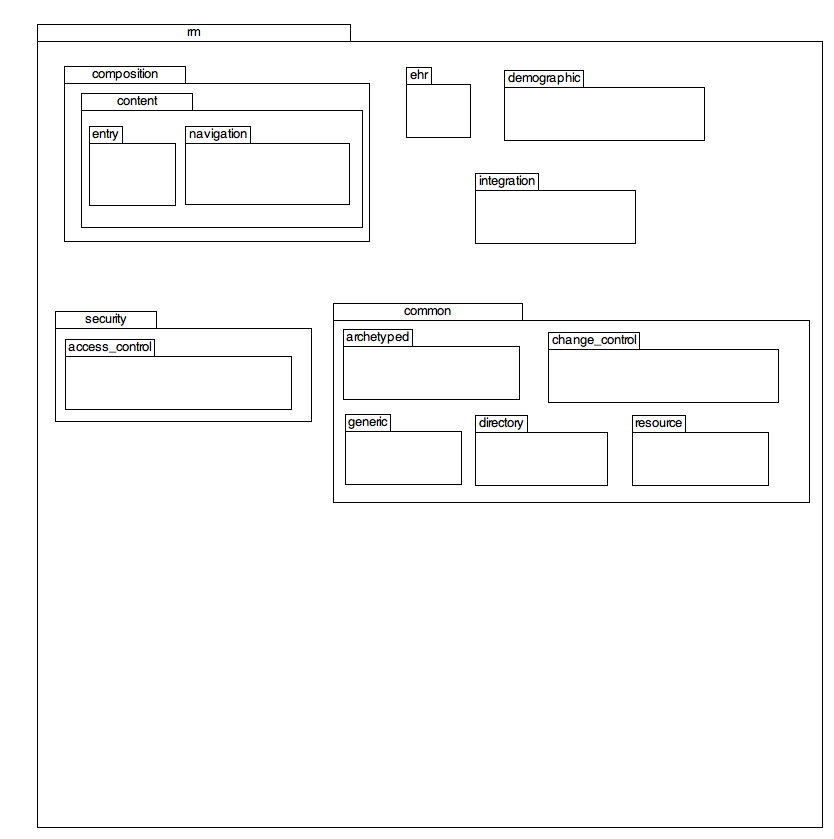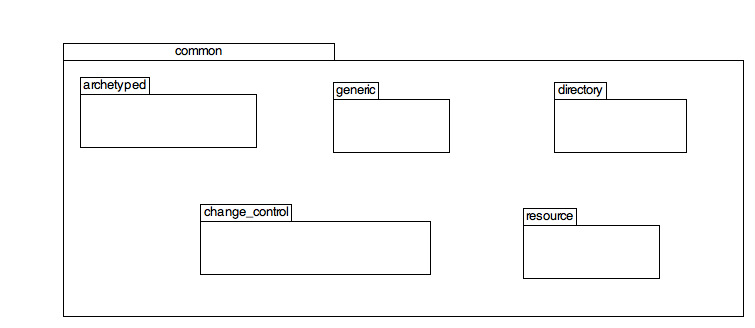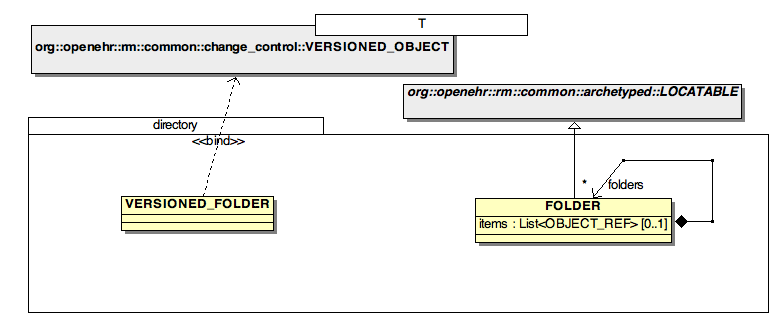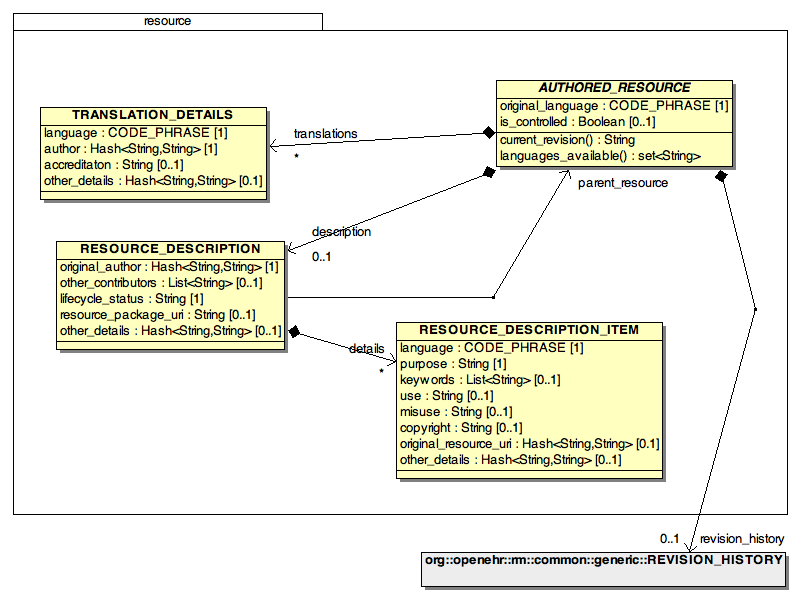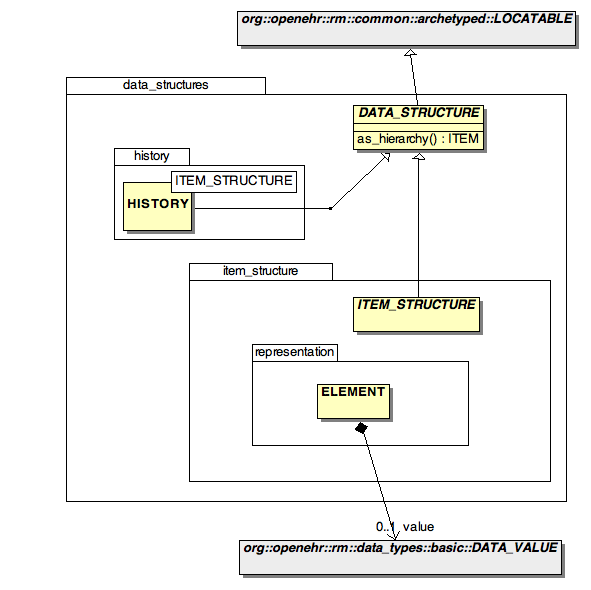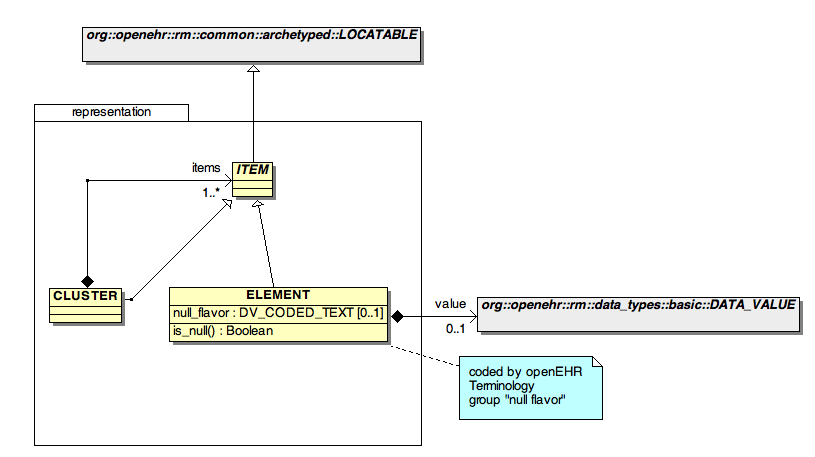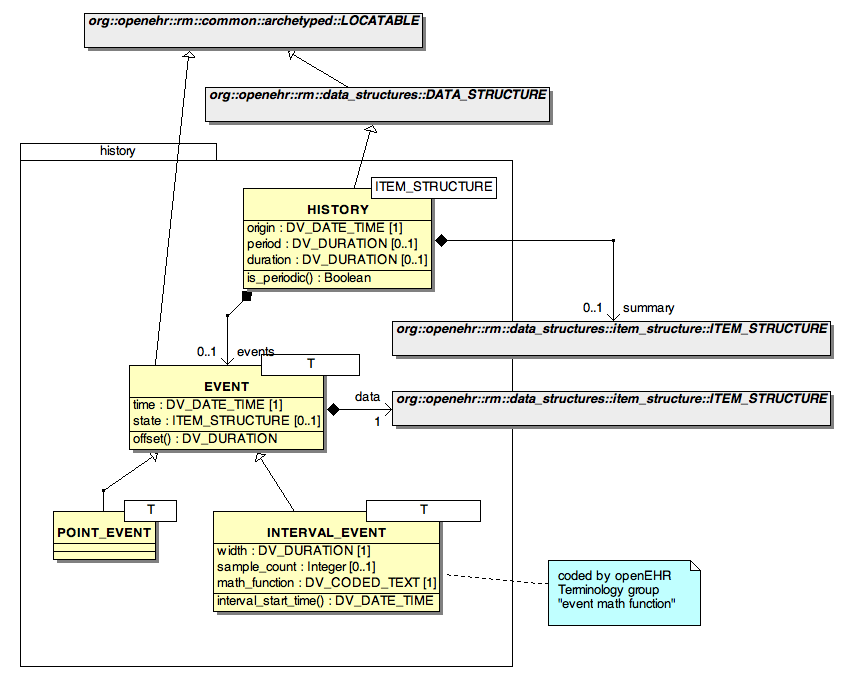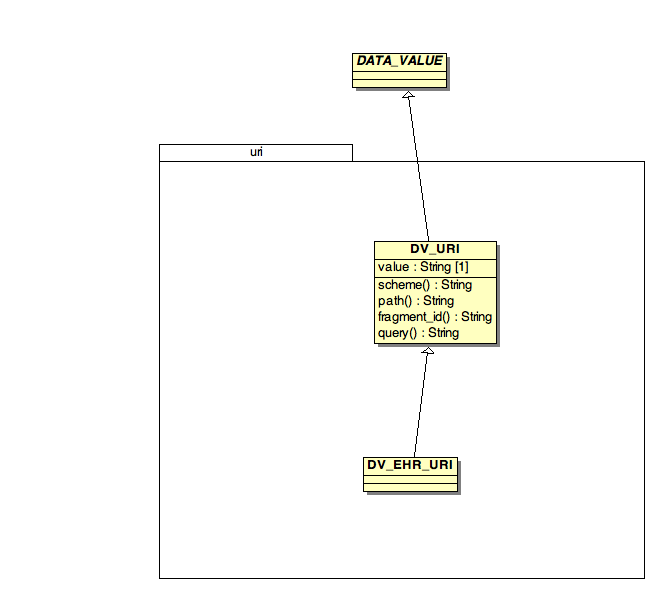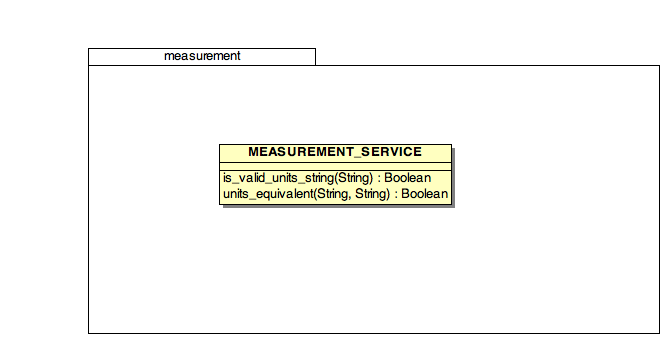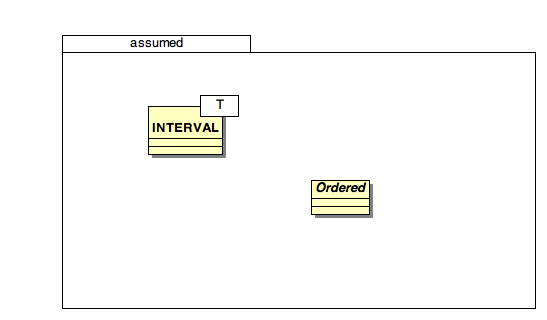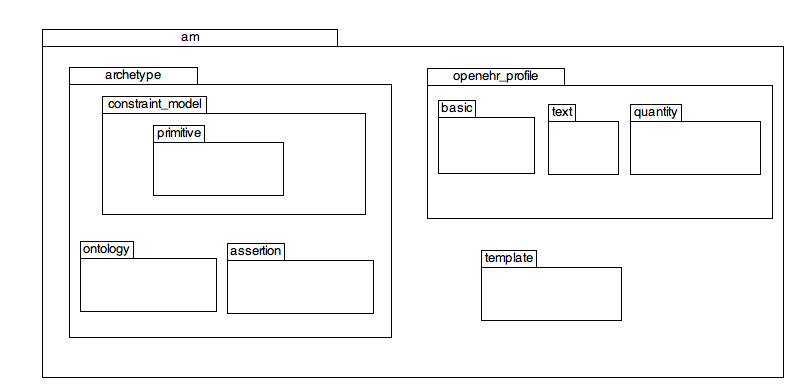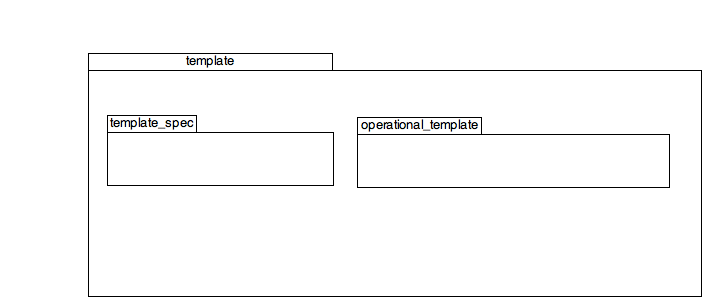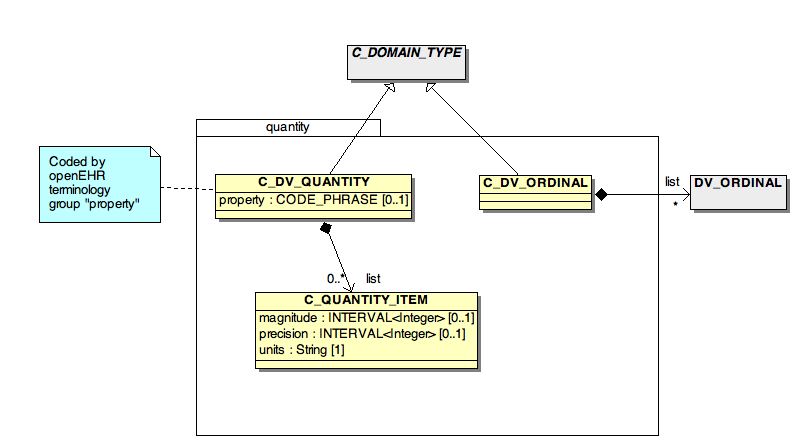1.1 Package openehr
The openEHR Foundation - see http://www.openehr.org
- C++ namespace : openehr
- Java package : org.openehr
1.1.1 Package rm
The openEHR Reference Model Release 1.0.1
- C++ namespace : openehr
- Java package : org.openehr.rm
1.1.1.1 Class View rm_overview
1.1.1.2 Deployment View rm_deploy
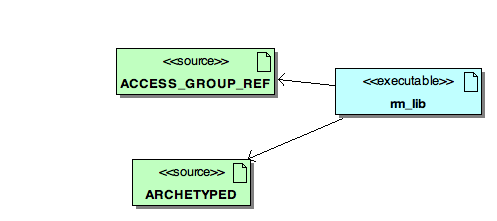
rm_lib_deploy
Artifact rm_lib |
Stereotype: executable
Properties:
- genpro footer:
- genpro config:debug warn_on qt
- genpro pro:/openehr/implementations/UML/openEHR_1.0.1/src/c++/rm/rm_lib.pro
- genpro path:/openehr/implementations/UML/1.0.1/src/c++/rm
- genpro includepath:../include/
- genpro defines:WITHCPP WITHJAVA WITHPHP WITHIDL
- genpro objectsdir:/openehr/implementations/UML/openEHR_1.0.1/target/c++/rm
- genpro dependpath:
- genpro target:/openehr/implementations/UML/openEHR_1.0.1/src/c++/rm/rm_lib
- genpro tmplt:app
executable associated with : Interval, PROPORTION_KIND, DV_TIME, GENERIC_ID, UID_BASED_ID, BASIC_DEFINITIONS, TERMINOLOGY_ID, CODE_PHRASE, DV_MULTIMEDIA, DV_ORDERED, DV_PROPORTION, DV_DATE_TIME, INTERNET_ID, DV_TEMPORAL, UID, ISO_OID, DV_DATE, TEMPLATE_ID, DV_DURATION, PATHABLE, DATA_VALUE, DV_BOOLEAN, ARCHETYPED, DV_COUNT, DV_ABSOLUTE_QUANTITY, DV_EHR_URI, LINK, PARTY_REF, DV_PARAGRAPH, GENERIC_ENTRY, Hash, HIER_OBJECT_ID, DV_PERIODIC_TIME_SPECIFICATION, DV_IDENTIFIER, LOCATABLE_REF, ACCESS_GROUP_REF, INTERVAL, FEEDER_AUDIT, REFERENCE_RANGE, DV_TEXT, DV_AMOUNT, OBJECT_ID, OBJECT_REF, DV_QUANTIFIED, DV_CODED_TEXT, Ordered, FEEDER_AUDIT_DETAILS, DV_ORDINAL, DV_GENERAL_TIME_SPECIFICATION, OPENEHR_DEFINITIONS, DV_QUANTITY, VERSION_TREE_ID, OBJECT_VERSION_ID, DV_TIME_SPECIFICATION, DV_INTERVAL, ARCHETYPE_ID, DV_URI, DV_ENCAPSULATED, LOCATABLE, UUID, TERM_MAPPING, DV_STATE, DV_PARSABLE
1.1.1.3 Package assumed_types
some Assumed Types for the openEHR Reference Model.
- C++ namespace : openehr
- Java package : org.openehr.rm.assumed_types
1.1.1.3.1 Class View assumed_types_cv
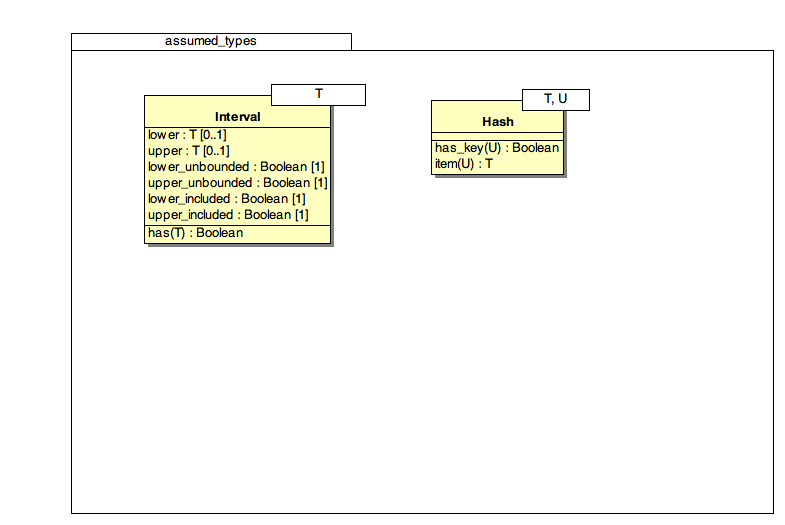
assumed_types_class_diag (rm)
Types normally provided by implementation technology via a class library.
Class Interval |
Class Hash |
1.1.1.3.2 Deployment View assumed_types_dv
1.1.1.4 Package common
The common Reference Model comprises a number of packages containing abstract concepts and
design patterns used in higher level openEHR models. Several concepts recur in higher level packages.
The classes LOCATABLE and ARCHETYPED provide the link between information and archetype models.
The classes ATTESTATION and PARTICIPATION are generic domain concepts that appear in various reference models.
The change_control package defines a formal model of change management and versioning which applies to
any service that needs to be able to supply previous states of its information, in particular the demographic and
EHR services.
- C++ namespace : openehr
- Java package : org.openehr.rm.common
1.1.1.4.1 Class View common_packages_cv
1.1.1.4.2 Package archetyped
The rm.common.archetyped package defines the core types PATHABLE, LOCATABLE, ARCHETYPED, and LINK
- C++ namespace : openehr
- Java package : org.openehr.rm.common.archetyped
1.1.1.4.2.1 Class View archetyped_cv
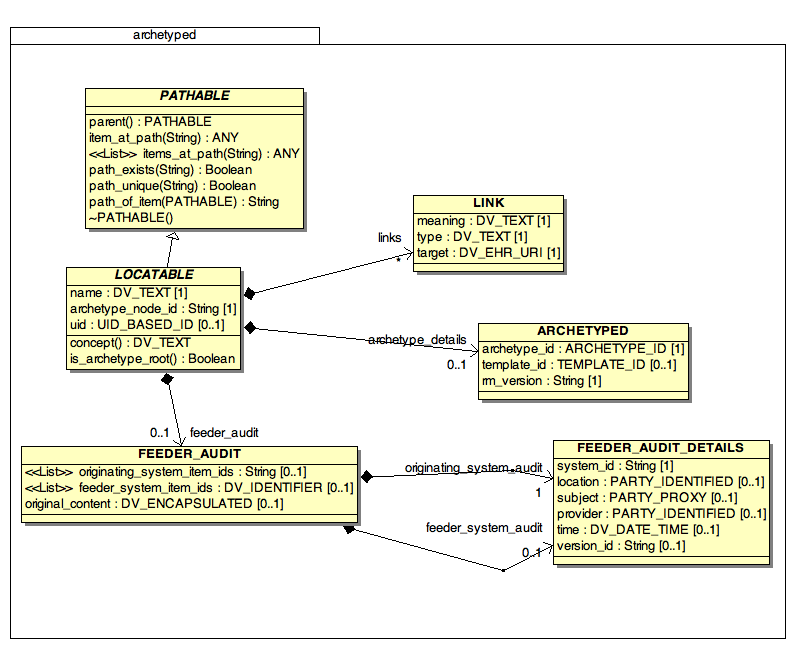
archetyped_class_diag (rm)
Classes in the rm.common.archetypes package.
Includes PATHABLE, LOCATABLE, ARCHETYPED and others.
Class PATHABLE |
Class LINK |
Class LOCATABLE |
Class ARCHETYPED |
Class FEEDER_AUDIT |
Class FEEDER_AUDIT_DETAILS |
1.1.1.4.2.2 Deployment View archetyped_dv
Artifact PATHABLE |
Stereotype: source
Artifact source associated with : PATHABLE
Artifact LINK |
Stereotype: source
Artifact source associated with : LINK
Artifact LOCATABLE |
Stereotype: source
Artifact source associated with : LOCATABLE
Artifact ARCHETYPED |
Stereotype: source
Artifact source associated with : ARCHETYPED
Artifact FEEDER_AUDIT |
Stereotype: source
Artifact source associated with : FEEDER_AUDIT
Artifact FEEDER_AUDIT_DETAILS |
Stereotype: source
Artifact source associated with : FEEDER_AUDIT_DETAILS
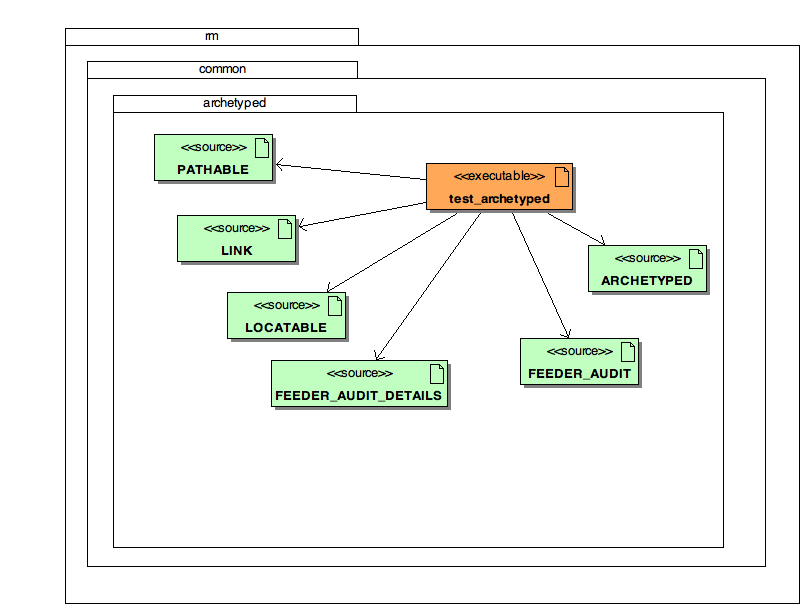
archetyped_deploy
Shows testing module layout for rm.common.archetyped package.
Artifact test_archetyped |
A module for testing the rm.common.archetyped package.
Depends on PATHABLE
Depends on LINK
Depends on ARCHETYPED
Depends on LOCATABLE
Depends on FEEDER_AUDIT_DETAILS
Depends on FEEDER_AUDIT
Stereotype: executable
Properties:
- genpro footer:
- genpro config:debug warn_on qt
- genpro pro:/openehr/implementations/UML/1.0.1/src/c++/rm/common/archetyped/test_arched.pro
- genpro path:/openehr/implementations/UML/1.0.1/src/c++/rm/common/archetyped
- genpro includepath:../../..
- genpro defines:WITHCPP WITHJAVA WITHPHP WITHIDL
- genpro objectsdir:/openehr/implementations/UML/1.0.1/target/c++/rm
- genpro dependpath:
- genpro target:/openehr/implementations/UML/1.0.1/src/c++/rm/common/archetyped/test_arched
- genpro tmplt:app
executable associated with : PATHABLE, ARCHETYPED, LINK, FEEDER_AUDIT, FEEDER_AUDIT_DETAILS, LOCATABLE
1.1.1.4.3 Package change_control
As described in the Architecture Overview document, formal version control and change
management are used in openEHR to support the construction of EHR and other repositories
requiring the properties of consistency, indelibility, traceability and distributed sharing. The
rm.common.change_control package supplies the formal specification of these features in openEHR.
- C++ namespace : openehr
- Java package : org.openehr.rm.common.change_control
1.1.1.4.3.1 Class View change_control_cv
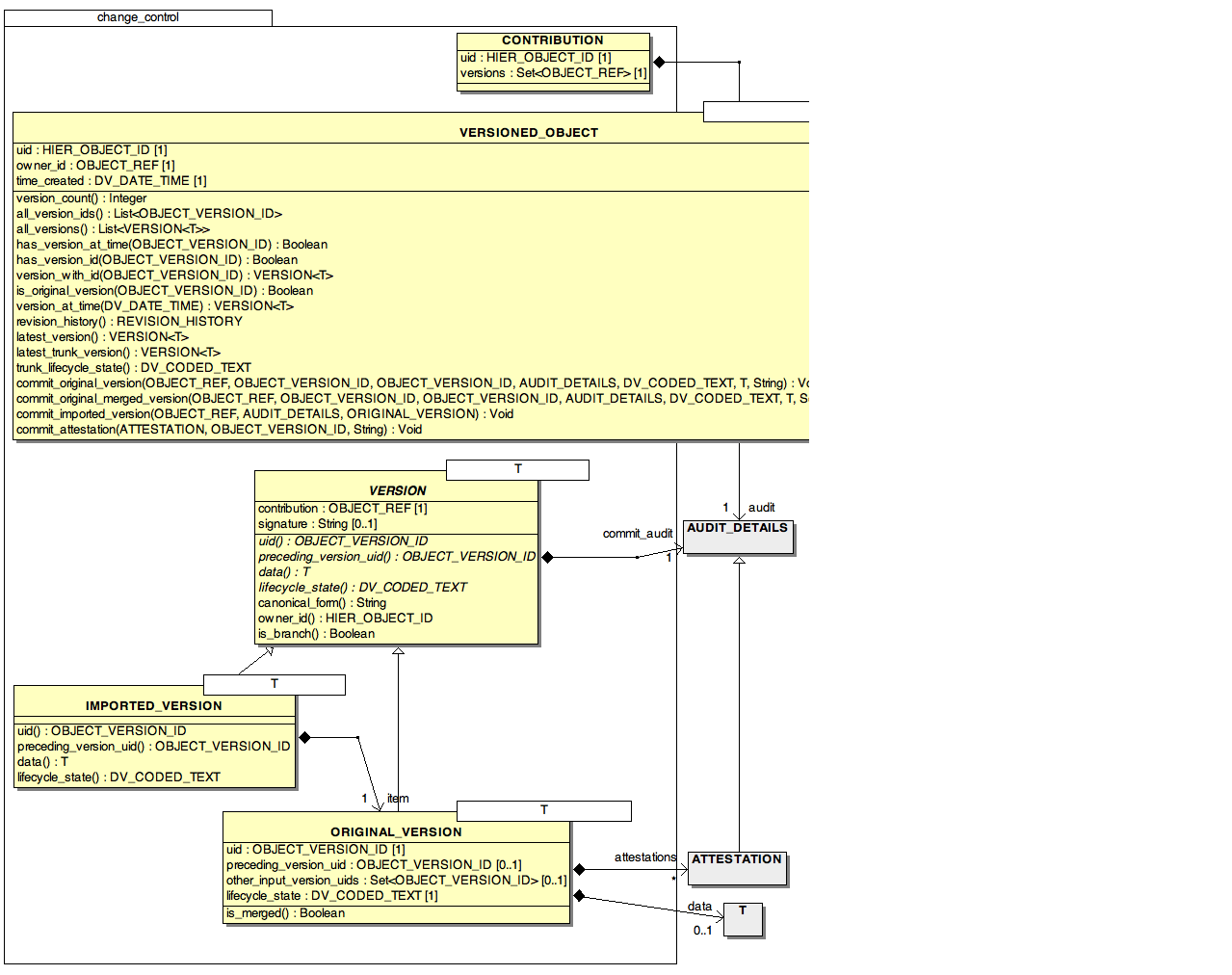
change_control_class_diag (rm)
Class VERSIONED_OBJECT |
Class CONTRIBUTION |
Class VERSION |
Class IMPORTED_VERSION |
Class ORIGINAL_VERSION |
Class T |
1.1.1.4.3.2 Deployment View change_control_dv
Artifact VERSIONED_OBJECT |
Stereotype: source
Artifact source associated with : VERSIONED_OBJECT
Artifact CONTRIBUTION |
Stereotype: source
Artifact source associated with : CONTRIBUTION
Artifact VERSION |
Stereotype: source
Artifact source associated with : VERSION
Artifact IMPORTED_VERSION |
Stereotype: source
Artifact source associated with : IMPORTED_VERSION
Artifact ORIGINAL_VERSION |
Stereotype: source
Artifact source associated with : ORIGINAL_VERSION
Artifact T |
Stereotype: source
Artifact source associated with : T
1.1.1.4.4 Package generic
The classes presented in the "rm.common.generic" package are abstractions of concepts which are generic patterns in the
domain of health (and most likely other domains), such as participation' and attestation'.
- C++ namespace : openehr
- Java package : org.openehr.rm.common.generic
1.1.1.4.4.1 Class View generic_cv
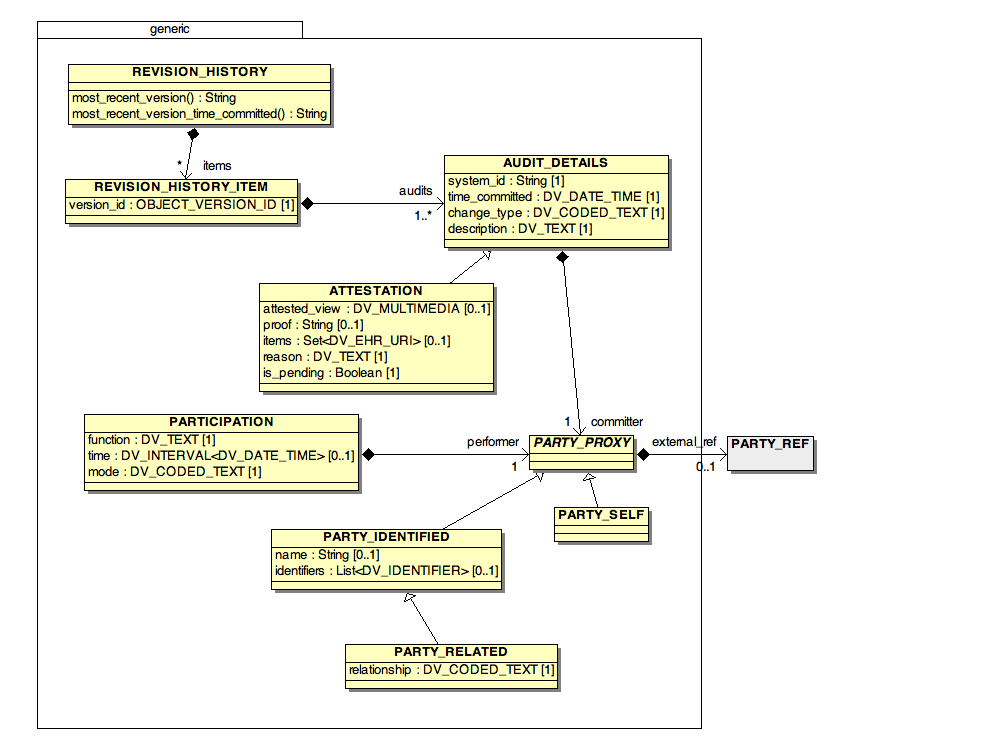
generic_class_diag
Class REVISION_HISTORY |
Class REVISION_HISTORY_ITEM |
Class AUDIT_DETAILS |
Class ATTESTATION |
Class PARTICIPATION |
Class PARTY_PROXY |
Class PARTY_IDENTIFIED |
Class PARTY_SELF |
Class PARTY_RELATED |
1.1.1.4.4.2 Deployment View generic_dv
Artifact REVISION_HISTORY |
Stereotype: source
Artifact source associated with : REVISION_HISTORY
Artifact REVISION_HISTORY_ITEM |
Stereotype: source
Artifact source associated with : REVISION_HISTORY_ITEM
Artifact AUDIT_DETAILS |
Stereotype: source
Artifact source associated with : AUDIT_DETAILS
Artifact ATTESTATION |
Stereotype: source
Artifact source associated with : ATTESTATION
Artifact PARTICIPATION |
Stereotype: source
Artifact source associated with : PARTICIPATION
Artifact PARTY_PROXY |
Stereotype: source
Artifact source associated with : PARTY_PROXY
Artifact PARTY_IDENTIFIED |
Stereotype: source
Artifact source associated with : PARTY_IDENTIFIED
Artifact PARTY_SELF |
Stereotype: source
Artifact source associated with : PARTY_SELF
Artifact PARTY_RELATED |
Stereotype: source
Artifact source associated with : PARTY_RELATED
1.1.1.4.5 Package directory
The rm.common.directory package provides a simple abstraction of a versioned
folder structure.
- C++ namespace : openehr
- Java package : org.openehr.rm.common.directory
1.1.1.4.5.1 Class View directory_cv
1.1.1.4.5.2 Deployment View directory_dv
Artifact VERSIONED_FOLDER |
Stereotype: source
Artifact source associated with : VERSIONED_FOLDER
Artifact FOLDER |
Stereotype: source
Artifact source associated with : FOLDER
1.1.1.4.6 Package resource
The rm.common.resource package defines the structure and semantics of the general notion of an online
resource which has been created by a human author, and consequently for which natural language is a
factor.
- C++ namespace : openehr
- Java package : org.openehr.rm.common.resource
1.1.1.4.6.1 Class View resource_cv
1.1.1.4.6.2 Deployment View resource_dv
Artifact AUTHORED_RESOURCE |
Stereotype: source
Artifact source associated with : AUTHORED_RESOURCE
Artifact RESOURCE_DESCRIPTION |
Stereotype: source
Artifact source associated with : RESOURCE_DESCRIPTION
Artifact TRANSLATION_DETAILS |
Stereotype: source
Artifact source associated with : TRANSLATION_DETAILS
Artifact RESOURCE_DESCRIPTION_ITEM |
Stereotype: source
Artifact source associated with : RESOURCE_DESCRIPTION_ITEM
1.1.1.5 Package data_structures
In most openEHR information models, generic data structures are used for expressing
content whose particular structure will be defined by archetypes. The generic structures
are as follows.
Single: single items, used to contain any single value, such as a height or weight.
List: linear lists of named items, such as many pathology test results.
Table: tabular data, including unlimited and limited length tables with named and
ordered columns, and potentially named rows.
Tree: tree-shaped data, which may be conceptually a list of lists, or other deep structure.
History: time-series structures, where each time-point can be an entire data structure
of any complexity, described by one of the above structure types. Point and interval
samples are supported.
- C++ namespace : openehr
- Java package : org.openehr.rm.data_structures
1.1.1.5.1 Class View data_structures_cv
1.1.1.5.2 Deployment View data_structures_dv
1.1.1.5.3 Package item_structure
- C++ namespace : openehr
- Java package : org.opernehr.rm.data_structures.item_structure
1.1.1.5.3.1 Class View item_structure_cv
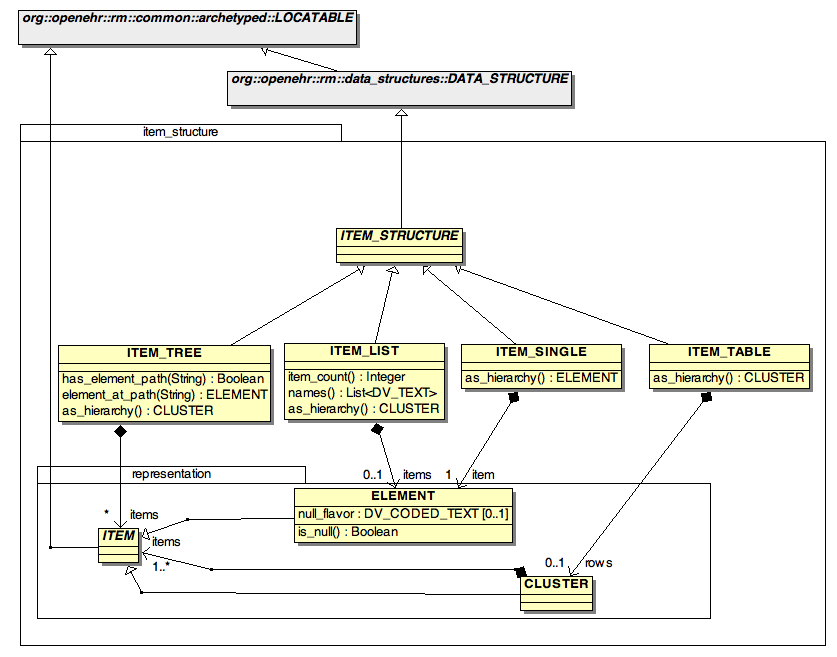
item_structure_class_diag (rm)
Class ITEM_STRUCTURE |
Class ITEM_TREE |
Class ITEM_SINGLE |
Class ITEM_TABLE |
Class ITEM_LIST |
1.1.1.5.3.2 Deployment View item_structure_dv
Artifact ITEM_STRUCTURE |
Stereotype: source
Artifact source associated with : ITEM_STRUCTURE
Artifact ITEM_TREE |
Stereotype: source
Artifact source associated with : ITEM_TREE
Artifact ITEM_SINGLE |
Stereotype: source
Artifact source associated with : ITEM_SINGLE
Artifact ITEM_TABLE |
Stereotype: source
Artifact source associated with : ITEM_TABLE
Artifact ITEM_LIST |
Stereotype: source
Artifact source associated with : ITEM_LIST
1.1.1.5.3.3 Package representation
The rm.data_structures.representation package contains classes for a simple hierarchical
representation of any data structure. These classes are compatible with the CEN EN13606
classes of the same names, and instances can be losslessly generated to and from
EN13606 instances structures.
- C++ namespace : openehr
- Java package : org.opernehr.rm.data_structures.item_structure.representation
1.1.1.5.4 Package history
- C++ namespace : openehr
- Java package : org.openehr.rm.data_structures.history
1.1.1.5.4.1 Class View history_cv
1.1.1.5.4.2 Deployment View history_dv
Artifact HISTORY |
Stereotype: source
Artifact source associated with : HISTORY
Artifact EVENT |
Stereotype: source
Artifact source associated with : EVENT
Artifact POINT_EVENT |
Stereotype: source
Artifact source associated with : POINT_EVENT
Artifact INTERVAL_EVENT |
Stereotype: source
Artifact source associated with : INTERVAL_EVENT
1.1.1.6 Package data_types
A set of clearly defined data types underlies all other models, and provides a number of general and clinically specific types required for all kinds of health information. The following categories of data types are defined in the data types reference model.
Text: plain text, coded text, paragraphs.
Quantities: any ordered type including ordinal values (used for representing symbolic ordered
values such as + , ++ , +++ ), measured quantities with values and units, and so on.
Date/times: date, time, date-time types, and partial date/time types.
Encapsulated data: multimedia, parsable content.
Basic types: boolean, state variable.
- C++ namespace : openehr
- Java package : org.openehr.rm.data_types
1.1.1.6.1 Package basic
- C++ namespace : openehr
- Java package : org.openehr.rm.data_types.basic
1.1.1.6.1.1 Class View basic_cv
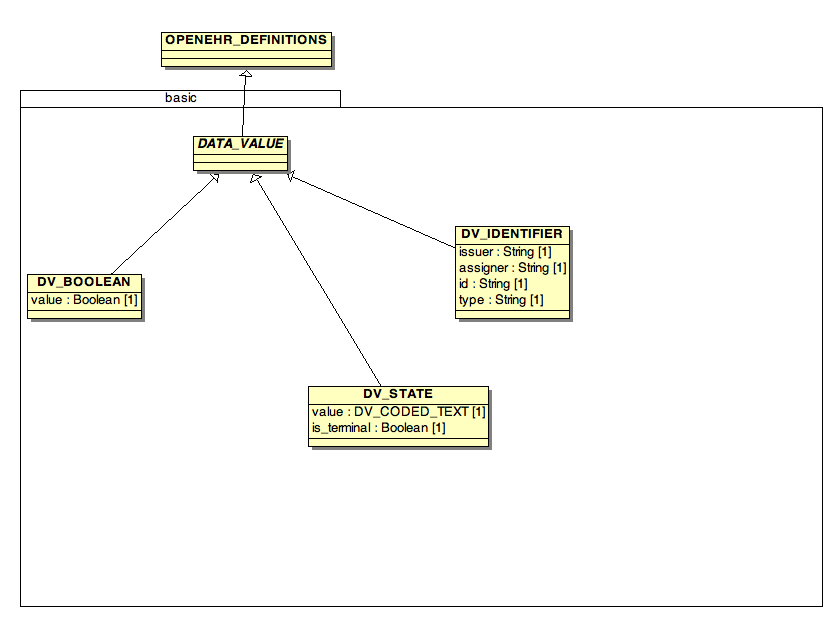
basic_class_diag (rm)
Classes in the rm.data_types.basic package.
Includes DATA_VALUE, DV_BOOLEAN, DV_STATE, DV_IDENTIFIER.
Class DATA_VALUE |
Class DV_BOOLEAN |
Class DV_STATE |
Class DV_IDENTIFIER |
1.1.1.6.1.2 Deployment View basic_dv
Artifact DATA_VALUE |
Stereotype: source
Artifact source associated with : DATA_VALUE
Artifact DV_BOOLEAN |
Stereotype: source
Artifact source associated with : DV_BOOLEAN
Artifact DV_STATE |
Stereotype: source
Artifact source associated with : DV_STATE
Artifact DV_IDENTIFIER |
Stereotype: source
Artifact source associated with : DV_IDENTIFIER
1.1.1.6.2 Package encapsulated
The data_types.encapsulated package contains classes representing data values whose internal
structure is defined outside the EHR model, such as multimedia and parsable data.
- C++ namespace : openehr
- Java package : org.openehr.rm.data_types.encapsulated
1.1.1.6.2.1 Class View encpsulated_cv
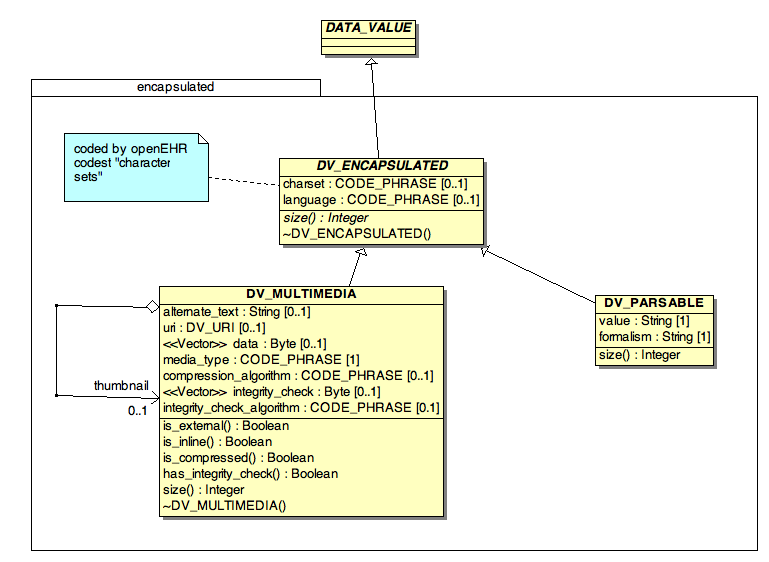
encapsulatd_class_diag
Classes in the rm.data_types.encapsulated package.
Includes DV_ENCAPSULATED, DV_MULTIMEDIA, DV_PARSABLE.
Class DV_ENCAPSULATED |
Class DV_MULTIMEDIA |
Class DV_PARSABLE |
1.1.1.6.2.2 Deployment View encapsulated_dv
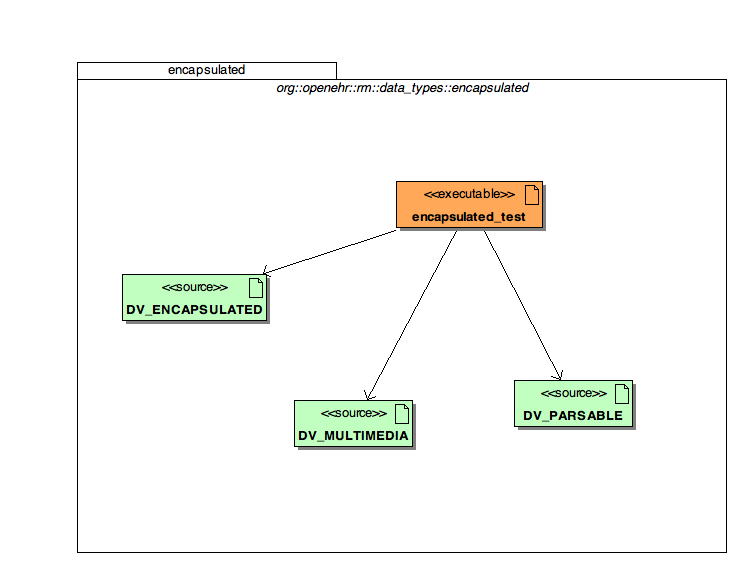
encapsulated_deploy
Shows testing module layout for rm.data_types.encapsulated package.
Artifact DV_ENCAPSULATED |
Stereotype: source
Artifact source associated with : DV_ENCAPSULATED
Artifact DV_MULTIMEDIA |
Stereotype: source
Artifact source associated with : DV_MULTIMEDIA
Artifact DV_PARSABLE |
Stereotype: source
Artifact source associated with : DV_PARSABLE
Artifact encapsulated_test |
A module for testing the rm.datatypes.encapsulated package.
Stereotype: executable
executable associated with : DV_MULTIMEDIA, DV_ENCAPSULATED, DV_PARSABLE
1.1.1.6.3 Package text
The rm.data_types.text package contains classes for representing all textual values in the health
record, including plain text, coded terms, and narrative text.
- C++ namespace : openehr
- Java package : org.openehr.rm.data_types.text
1.1.1.6.3.1 Class View text_cv
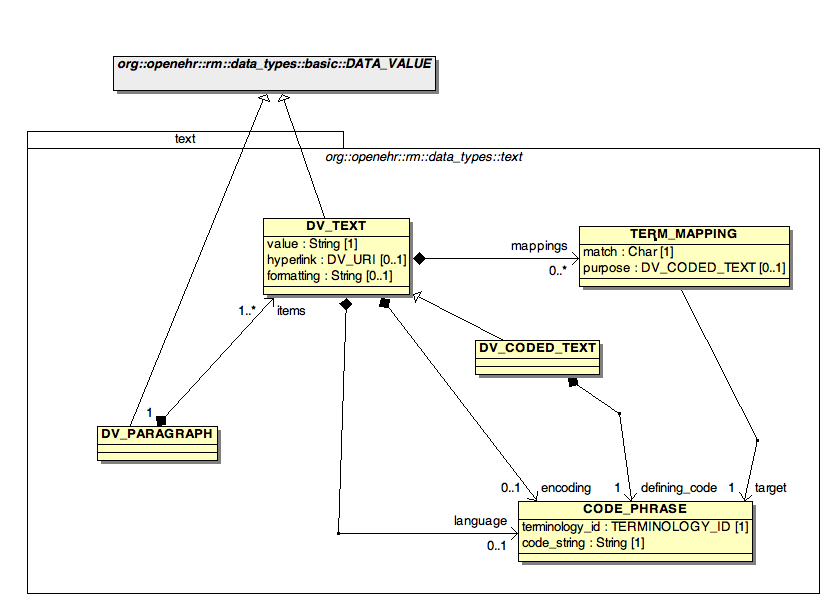
text_class_diag (rm)
Classes provided by the rm.data_types.text package.
Class DV_PARAGRAPH |
Class DV_TEXT |
Class DV_CODED_TEXT |
Class TERM_MAPPING |
Class CODE_PHRASE |
1.1.1.6.3.2 Deployment View text_dv
Artifact DV_PARAGRAPH |
Stereotype: source
Artifact source associated with : DV_PARAGRAPH
Artifact DV_TEXT |
Stereotype: source
Artifact source associated with : DV_TEXT
Artifact DV_CODED_TEXT |
Stereotype: source
Artifact source associated with : DV_CODED_TEXT
Artifact TERM_MAPPING |
Stereotype: source
Artifact source associated with : TERM_MAPPING
Artifact CODE_PHRASE |
Stereotype: source
Artifact source associated with : CODE_PHRASE
1.1.1.6.4 Package quantity
The rm.data_types.quantity package.
- C++ namespace : openehr
- Java package : org.openehr.rm.data_types.quantity
1.1.1.6.4.1 Class View quantity_cv
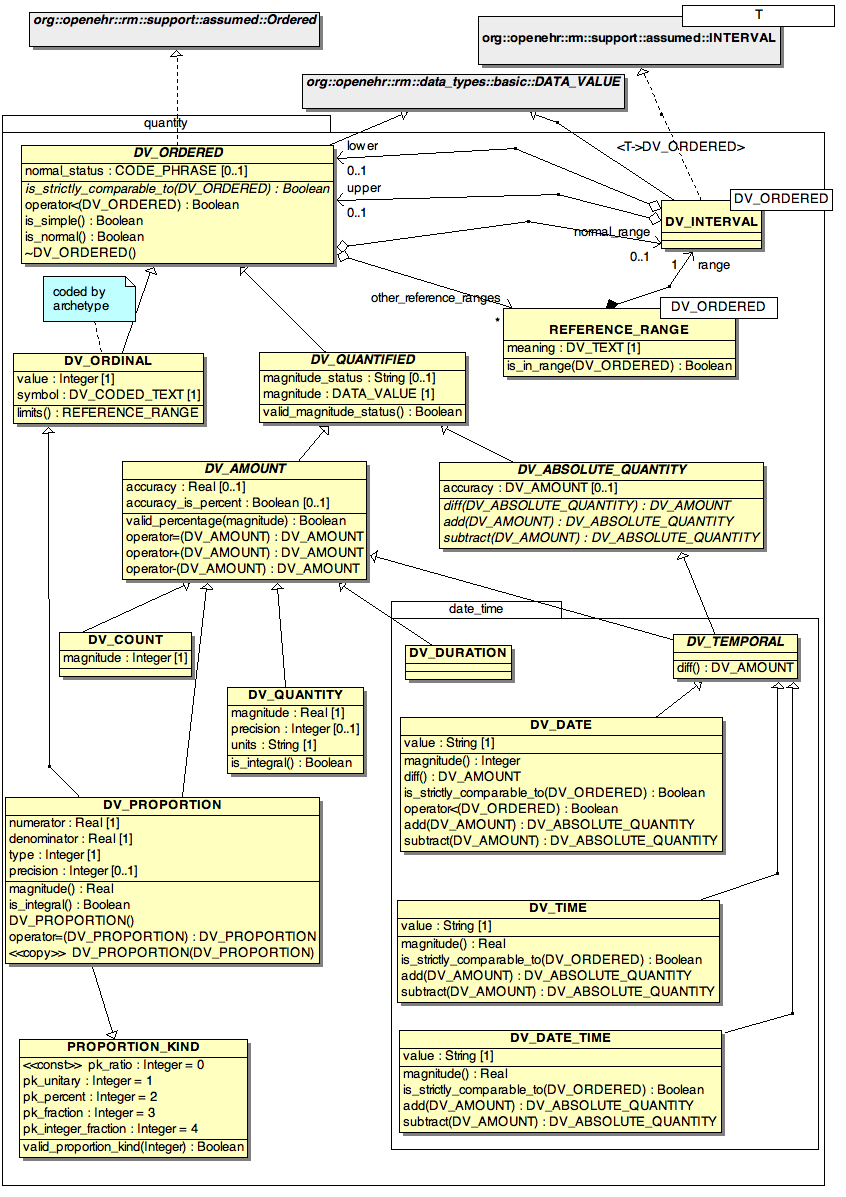
quantity_class_diag (rm)
Classes in the rm.data_types.quantity package.
IncludesDV_ORDERED, DV_INTERVAL, DV_QUANTIFIED and others.
Class DV_ORDERED |
Class DV_INTERVAL |
Class REFERENCE_RANGE |
Class DV_ORDINAL |
Class DV_QUANTIFIED |
Class DV_PROPORTION |
Class PROPORTION_KIND |
Class DV_AMOUNT |
Class DV_QUANTITY |
Class DV_COUNT |
Class DV_ABSOLUTE_QUANTITY |
1.1.1.6.4.2 Package date_time
- C++ namespace : openehr
- Java package : org.openehr.rm.data_types.quantity.date_time
1.1.1.6.4.2.1 Class View date_time_cv
1.1.1.6.4.2.2 Deployment View date_time_dv
Artifact DV_DURATION |
Stereotype: source
Artifact source associated with : DV_DURATION
Artifact DV_TEMPORAL |
Stereotype: source
Artifact source associated with : DV_TEMPORAL
Artifact DV_DATE |
Stereotype: source
Artifact source associated with : DV_DATE
Artifact DV_TIME |
Stereotype: source
Artifact source associated with : DV_TIME
Artifact DV_DATE_TIME |
Stereotype: source
Artifact source associated with : DV_DATE_TIME
1.1.1.6.4.3 Deployment View quantity_dv
Artifact DV_ORDERED |
Stereotype: source
Artifact source associated with : DV_ORDERED
Artifact DV_INTERVAL |
Stereotype: source
Artifact source associated with : DV_INTERVAL
Artifact REFERENCE_RANGE |
Stereotype: source
Artifact source associated with : REFERENCE_RANGE
Artifact DV_ORDINAL |
Stereotype: source
Artifact source associated with : DV_ORDINAL
Artifact DV_QUANTIFIED |
Stereotype: source
Artifact source associated with : DV_QUANTIFIED
Artifact DV_PROPORTION |
Stereotype: source
Artifact source associated with : DV_PROPORTION
Artifact PROPORTION_KIND |
Stereotype: source
Artifact source associated with : PROPORTION_KIND
Artifact DV_AMOUNT |
Stereotype: source
Artifact source associated with : DV_AMOUNT
Artifact DV_QUANTITY |
Stereotype: source
Artifact source associated with : DV_QUANTITY
Artifact DV_COUNT |
Stereotype: source
Artifact source associated with : DV_COUNT
Artifact DV_ABSOLUTE_QUANTITY |
Stereotype: source
Artifact source associated with : DV_ABSOLUTE_QUANTITY
1.1.1.6.5 Package time_specification
Time specification is about potentiality rather than actuality, and needs its own types. The openEHR
data_types.time_specification package provides such types, based on the HL7 types of the
same names
- C++ namespace : openehr
- Java package : org.openehr.rm.data_types.time_specification
1.1.1.6.5.1 Class View time_specification_cv
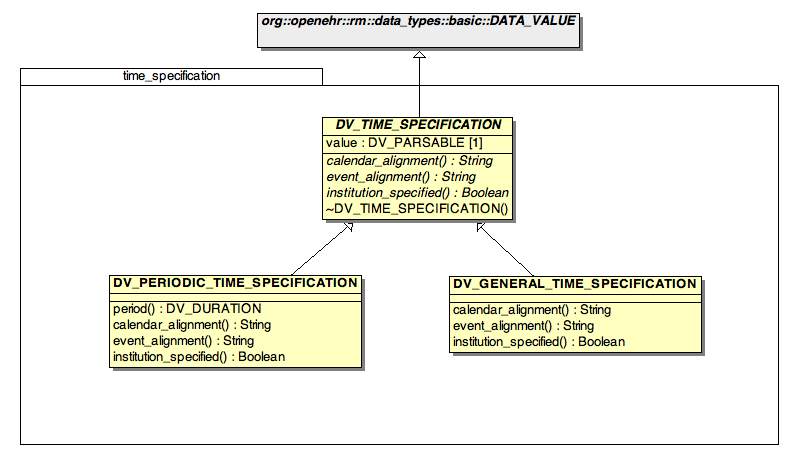
time_specification_class_diag (rm)
Classes in the rm.data_types.time_specification package.
Includes DV_TIME_SPECIFICATION, DV_PERIODIC_TIME_SPECIFICATION,
DV_GENERAL_TIME_SPECIFICATION.
Class DV_TIME_SPECIFICATION |
1.1.1.6.5.2 Deployment View time_specification_dv
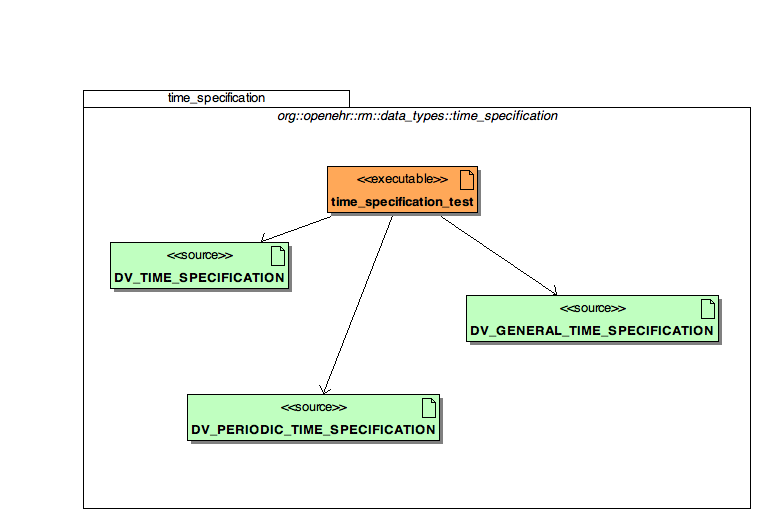
time_specification_deploy
Shows testing module layout for rm.datatypes.time_specification package.
Artifact time_specification_test |
A module for testing the rm.data_types.time_specification package.
Stereotype: executable
Properties:
- genpro footer:
- genpro config:debug warn_on qt
- genpro pro:/openehr/implementations/UML/1.0.1/src/c++/rm/data_types/time_specification/time_specification_test.pro
- genpro path:/openehr/implementations/UML/1.0.1/src/c++
- genpro includepath:../../include
- genpro defines:WITHCPP WITHJAVA WITHPHP WITHIDL
- genpro objectsdir:/openehr/implementations/UML/1.0.1/target/c++/rm/time_specification_test
- genpro dependpath:
- genpro target:/openehr/implementations/UML/1.0.1/src/c++/rm/data_types/time_specification/time_specification_test
- genpro tmplt:app
executable associated with : DV_PERIODIC_TIME_SPECIFICATION, DV_GENERAL_TIME_SPECIFICATION, DV_TIME_SPECIFICATION
Artifact DV_TIME_SPECIFICATION |
Stereotype: source
Artifact source associated with : DV_TIME_SPECIFICATION
Artifact DV_PERIODIC_TIME_SPECIFICATION |
Stereotype: source
Artifact source associated with : DV_PERIODIC_TIME_SPECIFICATION
Artifact DV_GENERAL_TIME_SPECIFICATION |
Stereotype: source
Artifact source associated with : DV_GENERAL_TIME_SPECIFICATION
1.1.1.6.6 Package uri
The data_types.uri package includes two types used for referring to information resources. The
DV_URI type allows data values which are references to objects on the world wide web to be created.
Its specialisation, DV_EHR_URI, enables any element in an openEHR record to be identified in the
same way as other objects on the web. The DV_EHR_URI type is convenient, because it is a string,
like any other URI, and is therefore easily transportable and processable. Because it has its own
scheme space, ehr , instances can be globally unique, as long as EHR identification is globally
unique. DV_EHR_URIs are used to express all runtime paths in the EHR.
- C++ namespace : openehr
- Java package : org.openehr.rm.data_types.uri
1.1.1.6.6.1 Class View uri_cv
1.1.1.6.6.2 Deployment View uri_dv
Artifact DV_URI |
Stereotype: source
Artifact source associated with : DV_URI
Artifact DV_EHR_URI |
Stereotype: source
Artifact source associated with : DV_EHR_URI
1.1.1.7 Package support
The rm.support package describes the most basic concepts, required by all other packages,
and is comprised of the Definitions, Identification, Terminology and Measurement packages.
The semantics defined in these packages allow all other models to use identifiers and to have
access to knowledge services like terminology and other reference data. The support package
includes the special package assumed_types, describing what basic types are assumed by
openEHR in external type systems; this package is a guide for integrating openEHR models
proper into the type systems of implementation technologies.
- C++ namespace : openehr
- Java package : org.openehr.rm.support
1.1.1.7.1 Class View support_packages_cv
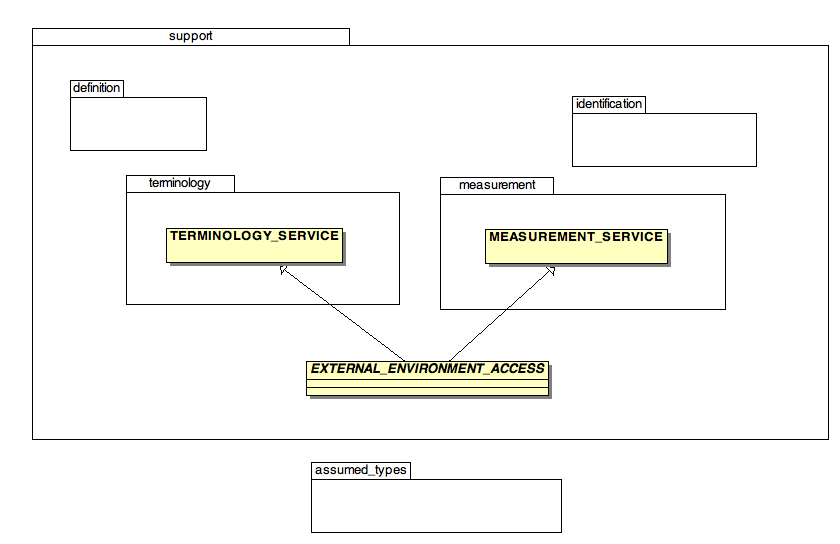
support_packages_OVERVIEW
Overview of the classes included in the Support package of the openEHR Reference Model.
1.1.1.7.2 Package definition
The rm.support.definition package defines symbolic definitions used by the
openEHR models. Only a small number are currently defined.
- C++ namespace : openehr
- Java package : org.openehr.rm.support.definition
1.1.1.7.2.1 Class View definition_cv
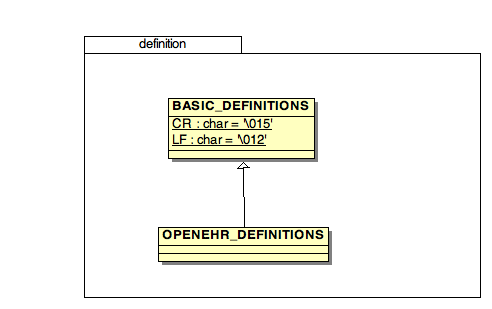
definition_class_diag (rm)
Classes in the rm.support.definition package.
Includes OPENEHR_DEFINITIONS, BASIC_DEFINITIONS.
Class OPENEHR_DEFINITIONS |
Class BASIC_DEFINITIONS |
1.1.1.7.2.2 Deployment View definition_dv
Artifact OPENEHR_DEFINITIONS |
Stereotype: source
Artifact source associated with : OPENEHR_DEFINITIONS
Artifact BASIC_DEFINITIONS |
Stereotype: source
Artifact source associated with : BASIC_DEFINITIONS
1.1.1.7.3 Package identification
The rm.support.identification package describes a model of references
and identifiers for information entities.
- C++ namespace : openehr
- Java package : org.openehr.rm.support.identification
1.1.1.7.3.1 Class View identification_cv
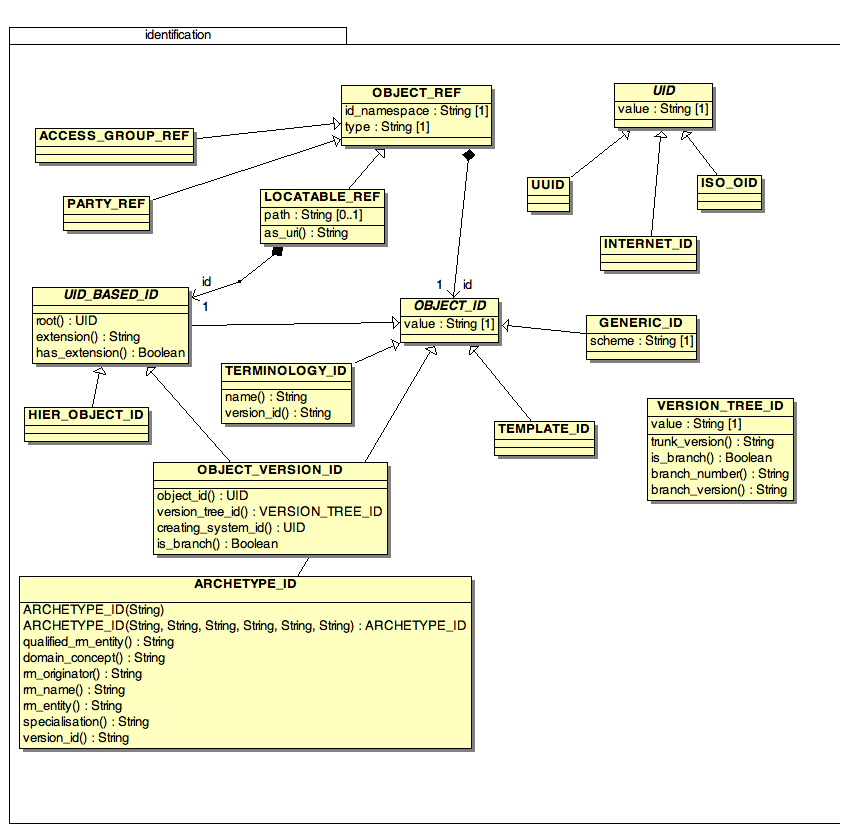
identification_class_diag (rm)
Classes in the rm.support.identification package.
Includes OBJECT_REF, OBJECT_ID, ARCHETYPE_ID and many others.
Class OBJECT_REF |
Class OBJECT_ID |
Class UID |
Class ACCESS_GROUP_REF |
Class PARTY_REF |
Class LOCATABLE_REF |
Class INTERNET_ID |
Class UUID |
Class ISO_OID |
Class TERMINOLOGY_ID |
Class UID_BASED_ID |
Class GENERIC_ID |
Class ARCHETYPE_ID |
Class TEMPLATE_ID |
Class OBJECT_VERSION_ID |
Class HIER_OBJECT_ID |
Class VERSION_TREE_ID |
1.1.1.7.3.2 Deployment View identification_dv
Artifact OBJECT_REF |
Stereotype: source
Artifact source associated with : OBJECT_REF
Artifact OBJECT_ID |
Stereotype: source
Artifact source associated with : OBJECT_ID
Artifact UID |
Stereotype: source
Artifact source associated with : UID
Artifact ACCESS_GROUP_REF |
Stereotype: source
Artifact source associated with : ACCESS_GROUP_REF
Artifact PARTY_REF |
Stereotype: source
Artifact source associated with : PARTY_REF
Artifact LOCATABLE_REF |
Stereotype: source
Artifact source associated with : LOCATABLE_REF
Artifact INTERNET_ID |
Stereotype: source
Artifact source associated with : INTERNET_ID
Artifact UUID |
Stereotype: source
Artifact source associated with : UUID
Artifact ISO_OID |
Stereotype: source
Artifact source associated with : ISO_OID
Artifact TERMINOLOGY_ID |
Stereotype: source
Artifact source associated with : TERMINOLOGY_ID
Artifact UID_BASED_ID |
Stereotype: source
Artifact source associated with : UID_BASED_ID
Artifact GENERIC_ID |
Stereotype: source
Artifact source associated with : GENERIC_ID
Artifact ARCHETYPE_ID |
Stereotype: source
Artifact source associated with : ARCHETYPE_ID
Artifact TEMPLATE_ID |
Stereotype: source
Artifact source associated with : TEMPLATE_ID
Artifact OBJECT_VERSION_ID |
Stereotype: source
Artifact source associated with : OBJECT_VERSION_ID
Artifact HIER_OBJECT_ID |
Stereotype: source
Artifact source associated with : HIER_OBJECT_ID
Artifact VERSION_TREE_ID |
Stereotype: source
Artifact source associated with : VERSION_TREE_ID
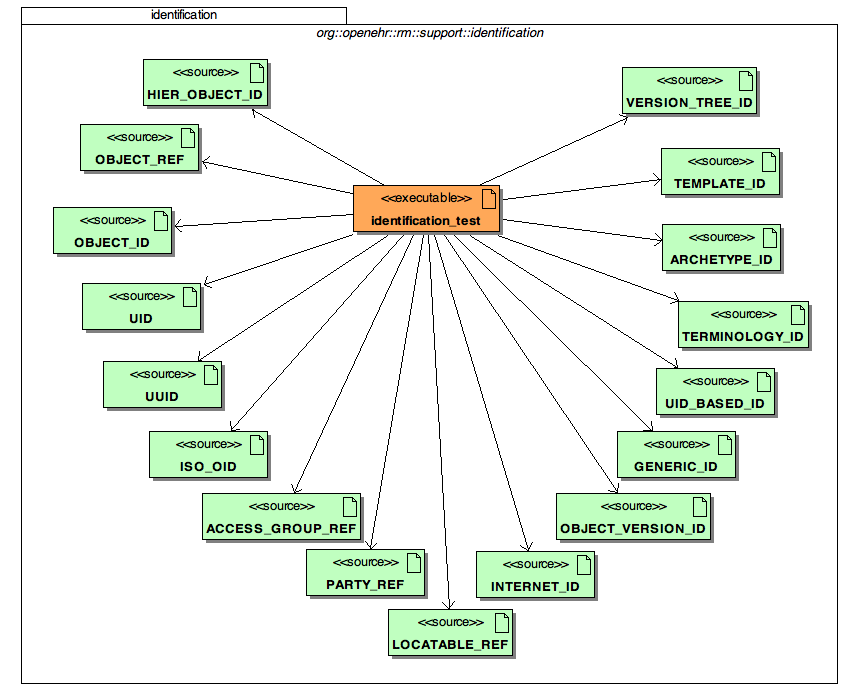
identification_deploy
Shows testing module layout for rm.support.identification package.
Artifact identification_test |
A module for testing the rm.support.identification package.
Stereotype: executable
Properties:
- genpro footer:
- genpro config:debug warn_on qt
- genpro pro:/openehr/implementations/UML/1.0.1/src/c++/rm/support/identification/identification_test.pro
- genpro path:/openehr/implementations/UML/1.0.1/src/c++/rm/support/identification
- genpro includepath:../../include
- genpro defines:WITHCPP WITHJAVA WITHPHP WITHIDL
- genpro objectsdir:/openehr/implementations/UML/1.0.1/target/c++/rm/identification_test
- genpro dependpath:
- genpro target:/openehr/implementations/UML/1.0.1/src/c++/rm/support/identification/identification_test
- genpro tmplt:app
executable associated with : GENERIC_ID, UID_BASED_ID, TERMINOLOGY_ID, INTERNET_ID, UID, ISO_OID, TEMPLATE_ID, PARTY_REF, HIER_OBJECT_ID, LOCATABLE_REF, ACCESS_GROUP_REF, OBJECT_ID, OBJECT_REF, VERSION_TREE_ID, OBJECT_VERSION_ID, ARCHETYPE_ID, UUID
1.1.1.7.4 Package measurement
The rm.support.measurement package defines a minimum of semantics relating to quantitative measurement,
units, and conversion, enabling the Quantity package of the openEHR Data Types Information Model
to be correctly expressed. As for the Terminology package, a simple service interface is assumed,
which provides useful functions to other parts of the reference model.
- C++ namespace : openehr
- Java package : org.openehr.rm.support.measurement
1.1.1.7.4.1 Class View measurement_cv
1.1.1.7.4.2 Deployment View measurement_dv
Artifact MEASUREMENT_SERVICE |
Stereotype: source
Artifact source associated with : MEASUREMENT_SERVICE
1.1.1.7.5 Package terminology
The rm.support.terminology package contains classes for accessing terminologies and code
sets, including the openEHR Support Terminology, from within instances of classes
defined in the reference model. The classes shown here would normally be inherited via
the classes EXTERNAL_ENVIRONMENT_ACCESS and OPENEHR_DEFINITIONS, although
the exact details of how this is done may vary depending on implementation language.
- C++ namespace : openehr
- Java package : org.openehr.rm.support.terminology
1.1.1.7.5.1 Class View terminology_cv
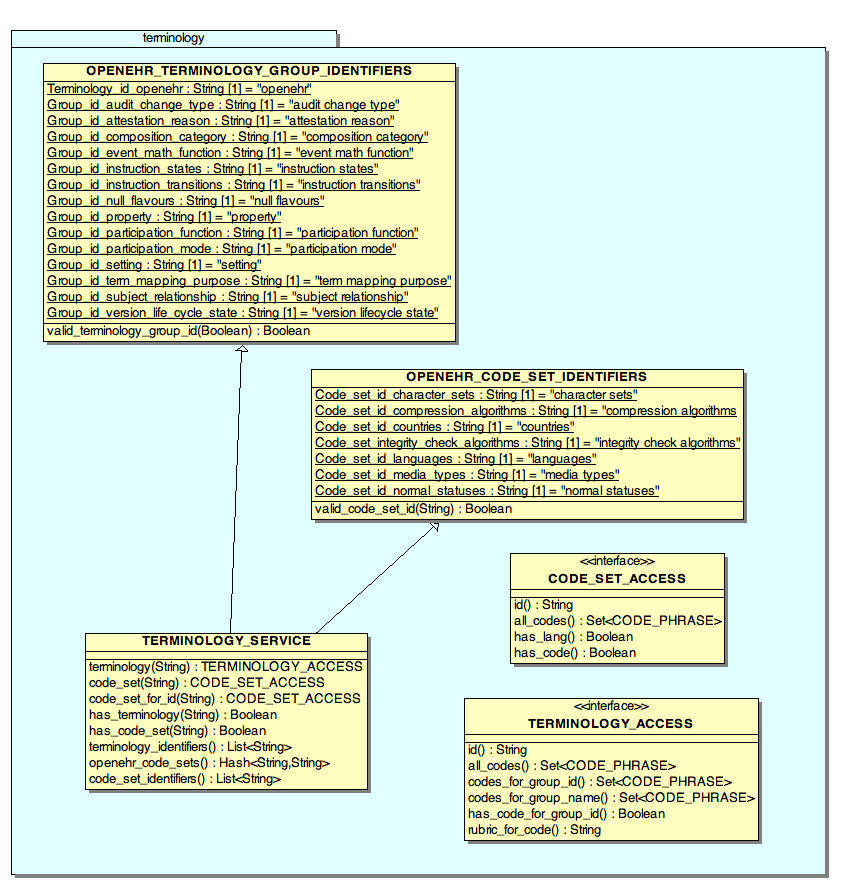
terminology_class_diag (rm)
Classes in the rm.support.terminology package.
Class CODE_SET_ACCESS |
Class TERMINOLOGY_ACCESS |
Class TERMINOLOGY_SERVICE |
1.1.1.7.5.2 Deployment View terminology_dv
Artifact OPENEHR_TERMINOLOGY_GROUP_IDENTIFIERS |
Stereotype: source
Artifact source associated with : OPENEHR_TERMINOLOGY_GROUP_IDENTIFIERS
Artifact OPENEHR_CODE_SET_IDENTIFIERS |
Stereotype: source
Artifact source associated with : OPENEHR_CODE_SET_IDENTIFIERS
Artifact CODE_SET_ACCESS |
Stereotype: source
Artifact source associated with : CODE_SET_ACCESS
Artifact TERMINOLOGY_ACCESS |
Stereotype: source
Artifact source associated with : TERMINOLOGY_ACCESS
Artifact TERMINOLOGY_SERVICE |
Stereotype: source
Artifact source associated with : TERMINOLOGY_SERVICE
1.1.1.7.6 Package assumed
- C++ namespace : openehr
- Java package : org.openehr.rm.support.assumed
1.1.1.8 Package security
The Security Information Model defines the semantics of access control
and privacy setting for information in the EHR
- C++ namespace : openehr
- Java package : org.openehr.rm.security
1.1.1.8.1 Package access_control
The rm.security.access_control package.
- C++ namespace : openehr
- Java package : org.openehr.rm.security.access_control
1.1.1.8.1.1 Class View access_control_cv
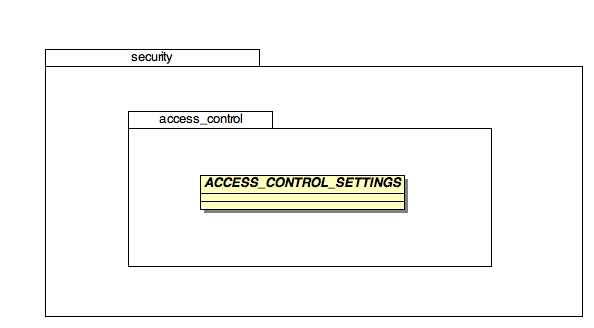
access_control_class_diag (rm)
Class diagram op the rm.security.access_control package.
Includes abstract class ACCESS_CONTROL_SETTINGS.
Class ACCESS_CONTROL_SETTINGS |
1.1.1.8.1.2 Deployment View access_control_dv
Artifact ACCESS_CONTROL_SETTINGS |
Stereotype: source
Artifact source associated with : ACCESS_CONTROL_SETTINGS
1.1.1.9 Package ehr
The EHR IM defines the containment and context semantics of the concepts EHR,
COMPOSITION, SECTION, and ENTRY. These classes are the major coarse-grained
components of the EHR, and correspond directly to the classes of the same names
in CEN EN13606:2005 and fairly closely to the levels of the same names in the
HL7 Clinical Document Architecture (CDA) release 2.0.
- C++ namespace : openehr
- Java package : org.openehr.rm.ehr
1.1.1.9.1 Class View ehr_cv
Class view for rm.ehr package.
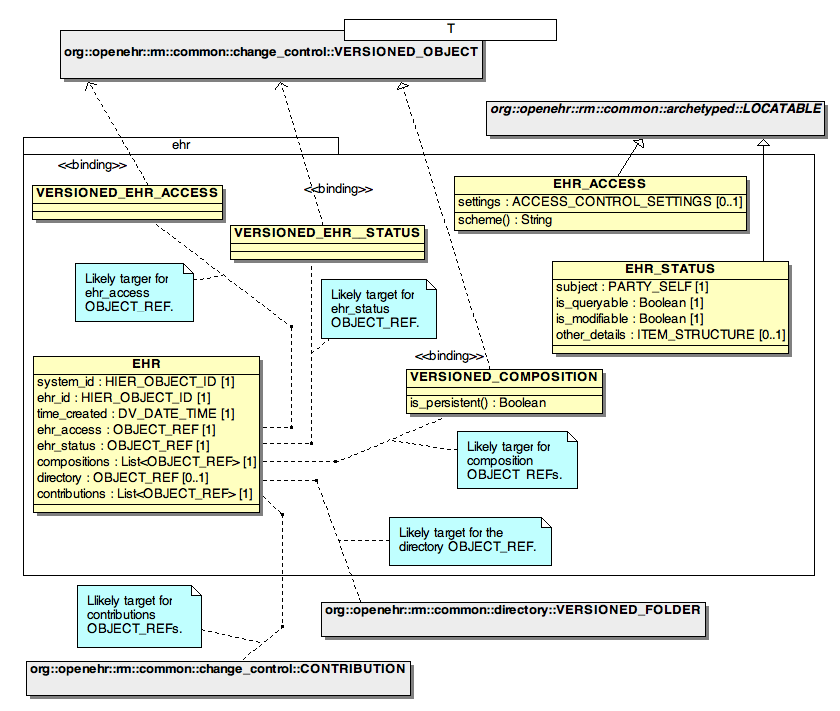
ehr_class_diag (rm)
Class diagram for the openEHR rm.ehr package.
Class EHR |
Class VERSIONED_EHR_ACCESS |
Class VERSIONED_EHR__STATUS |
Class VERSIONED_COMPOSITION |
Class EHR_ACCESS |
Class EHR_STATUS |
1.1.1.9.2 Deployment View ehr_dv
Artifact EHR |
Stereotype: source
Artifact source associated with : EHR
Artifact VERSIONED_EHR_ACCESS |
Stereotype: source
Artifact source associated with : VERSIONED_EHR_ACCESS
Artifact VERSIONED_EHR__STATUS |
Stereotype: source
Artifact source associated with : VERSIONED_EHR__STATUS
Artifact VERSIONED_COMPOSITION |
Stereotype: source
Artifact source associated with : VERSIONED_COMPOSITION
Artifact EHR_ACCESS |
Stereotype: source
Artifact source associated with : EHR_ACCESS
Artifact EHR_STATUS |
Stereotype: source
Artifact source associated with : EHR_STATUS
1.1.1.10 Package ehr_extract
The EHR Extract IM defines how an EHR extract is built from COMPOSITIONs, demographic, and access control information from the EHR. A number of Extract variations are supported, including full openEHR , a simplified form for integration with CEN EN13606, and an openEHR/openEHR synchronisation Extract.
- C++ namespace : openehr
- Java package : org.openehr.rm.include
1.1.1.11 Package demographic
The demographic model defines generic concepts of PARTY, ROLE and related details such as contact addresses. The archetype model defines the semantics of constraint on PARTYs, allowing archetypes for any type of person, organisation, role and role relationship to be described. This approach provides a flexible way of including the arbitrary demographic attributes allowed in the OMG HDTF
PIDS standard.
- C++ namespace : openehr
- Java package : org.openehr.rm.demographics
1.1.1.12 Package integration
The Integration model defines the class GENERIC_ENTRY, a subtype of ENTRY used to represent free-form legacy or external data as a tree. This Entry type has its own archetypes, known as integration archetypes , which can be used in concert with clinical archetypes as the basis for a tool-based data integration system.
- C++ namespace : openehr
- Java package : org.openehr.rm.integration
1.1.1.12.1 Class View integration_cv
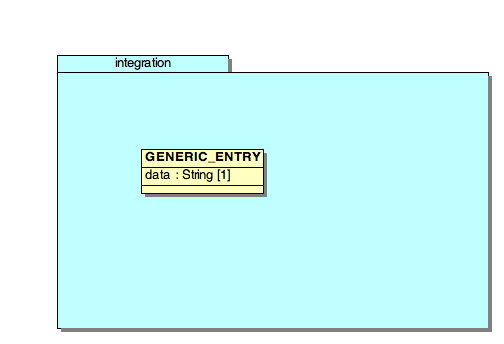
integration_class_diag
Classes in the rm.integration package.
Includes GENERIC_ENTRY.
Class GENERIC_ENTRY |
1.1.1.12.2 Deployment View integration_dv
1.1.1.13 Package composition
The rm.composition package.
The Composition is the primary data container' in the openEHR EHR and
is the root point of clinical content. Instances of the Composition class
can be considered as self-standing data aggregations, or documents in a
document-oriented system. The key information in a COMPOSITION is
found in its content, context, and composer attributes.
- C++ namespace : openehr
- Java package : org.openehr.rm.composition
1.1.1.13.1 Class View composition_cv
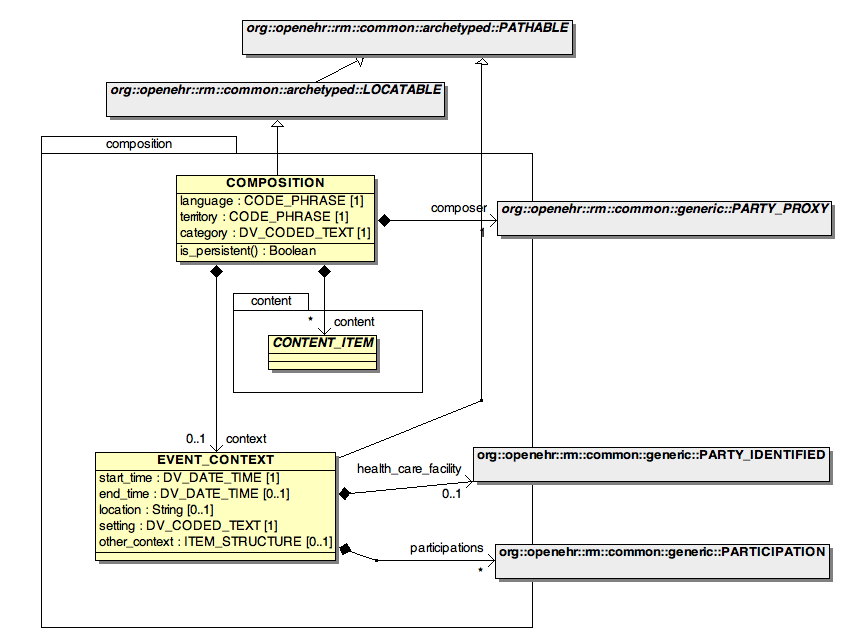
composition_class_diag (rm)
Class diagram of the rm.composition package.
Includes COMPOSITION and EVENT_CONTEXT classes and the content package.
Class COMPOSITION |
Class EVENT_CONTEXT |
1.1.1.13.2 Deployment View composition_dv
1.1.1.13.3 Package content
The content package contains the CONTENT_ITEM class, ancestor
class of all content types, and the navigation and entry packages,
which contain SECTION, ENTRY and related types.
- C++ namespace : openehr
- Java package : org.openehr.rm.composition.content
1.1.1.13.3.1 Class View content_cv
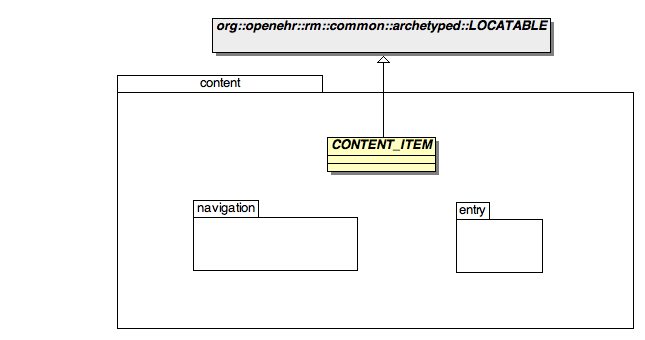
content_class_diag (rm)
Class diagram for the rm.composition.content package.
Includes abstact class CONTENT_ITEM and the navigation and entry packages.
Class CONTENT_ITEM |
1.1.1.13.3.2 Deployment View content_dv
1.1.1.13.3.3 Package navigation
The rm.composition.content.navigation Package defines a hierachical heading
structure, in which all individual headings are considered to belong to a
tree of headings . Each heading is an instance of the class SECTION.
- C++ namespace : openehr
- Java package : org.openehr.rm.composition.content.navigation
1.1.1.13.3.3.1 Class View navigation_cv
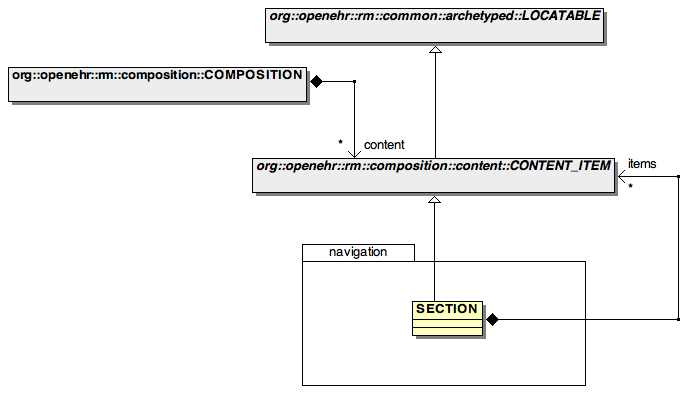
navigation_class_diag (rm)
Class diagram for the rm.composition.content.navigation package.
Includes the SECTION class.
Class SECTION |
1.1.1.13.3.3.2 Deployment View navigation_dv
1.1.1.13.3.4 Package entry
The rm.composition.content.entry package.
All information which is created in the openEHR health record is expressed as an instance
of a class in the entry package, containing the ENTRY class and a number of descendants.
An ENTRY instance is logically a single clinical statement', and may be a single short
narrative phrase, but may also contain a significant amount of data, e.g. an entire
microbiology result, a psychiatric examination, a complex prescription. In terms of actual
content, the Entry classes are the most important in the openEHR EHR Information Model,
since they define the semantics of all the hard' information in the record.
They are intended to be archetyped, and in fact, archetypes for Entries make up the vast
majority of important clinical archetypes defined.
- C++ namespace : openehr
- Java package : org.openehr.rm.composition.content.entry
1.1.1.13.3.4.1 Class View entry_cv
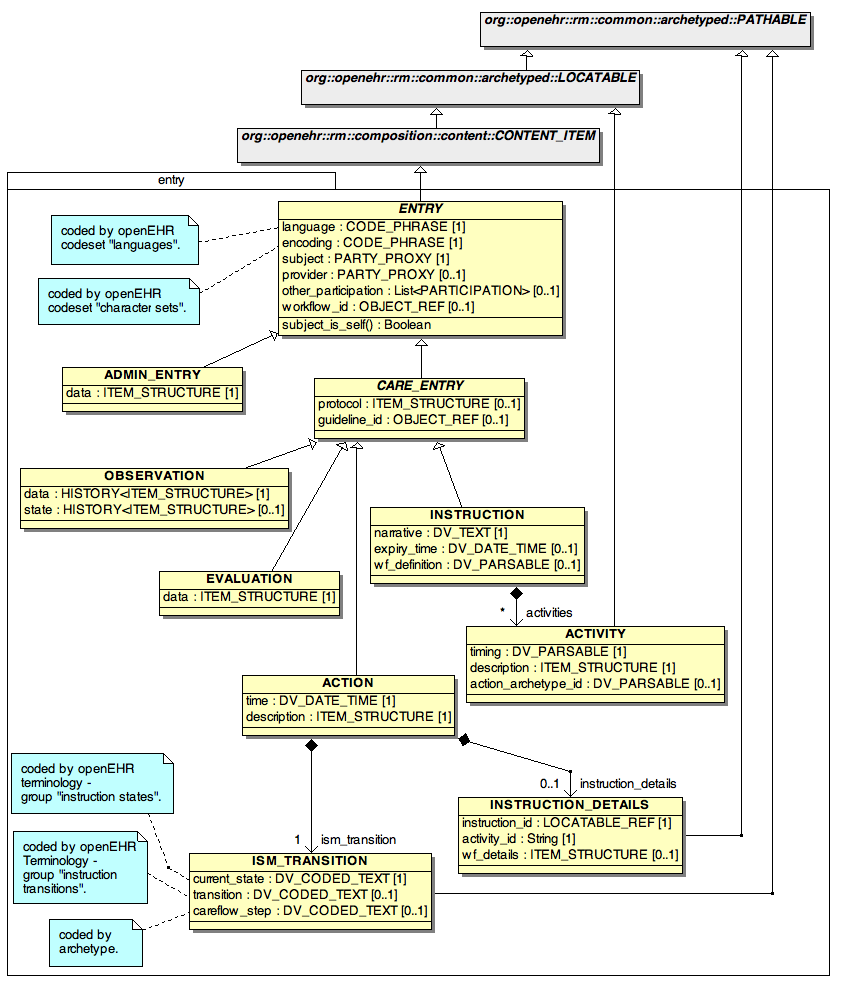
entry_class_diag (rm)
Class diagram for the rm.composition.content.entry package.
Includes abstract ENTRY class and the primary entry classes
OBSERVATION, EVALUATION, INSTRUCTION, ACTION.
Class ENTRY |
Class ADMIN_ENTRY |
Class CARE_ENTRY |
Class OBSERVATION |
Class EVALUATION |
Class INSTRUCTION |
Class ACTION |
Class ACTIVITY |
Class ISM_TRANSITION |
Class INSTRUCTION_DETAILS |
1.1.1.13.3.4.2 Deployment View entry_dv
Artifact ENTRY |
Stereotype: source
Artifact source associated with : ENTRY
Artifact ADMIN_ENTRY |
Stereotype: source
Artifact source associated with : ADMIN_ENTRY
Artifact CARE_ENTRY |
Stereotype: source
Artifact source associated with : CARE_ENTRY
Artifact OBSERVATION |
Stereotype: source
Artifact source associated with : OBSERVATION
Artifact EVALUATION |
Stereotype: source
Artifact source associated with : EVALUATION
Artifact INSTRUCTION |
Stereotype: source
Artifact source associated with : INSTRUCTION
Artifact ACTION |
Stereotype: source
Artifact source associated with : ACTION
Artifact ACTIVITY |
Stereotype: source
Artifact source associated with : ACTIVITY
Artifact ISM_TRANSITION |
Stereotype: source
Artifact source associated with : ISM_TRANSITION
Artifact INSTRUCTION_DETAILS |
Stereotype: source
Artifact source associated with : INSTRUCTION_DETAILS
1.1.2 Package am
The openEHR am package contains the models necessary to describe the semantics of archetypes and templates, and their use within openEHR. These include ADL, the Archetype Definition Language (expressed in the form of a syntax specification), the archetype and template packages, defining the object-oriented semantics of archetypes and templates, and the openehr_profile package, which defines a profile of the generic archetype model defined in the archetype package, for use in openEHR (and other health computing endeavours).
- C++ namespace : openehr
- Java package : org.openehr.am
1.1.2.1 Class View am_cv
1.1.2.2 Package archetype
- C++ namespace : openehr
- Java package : org.openehr.am.archetype
1.1.2.2.1 Class View archetype_cv
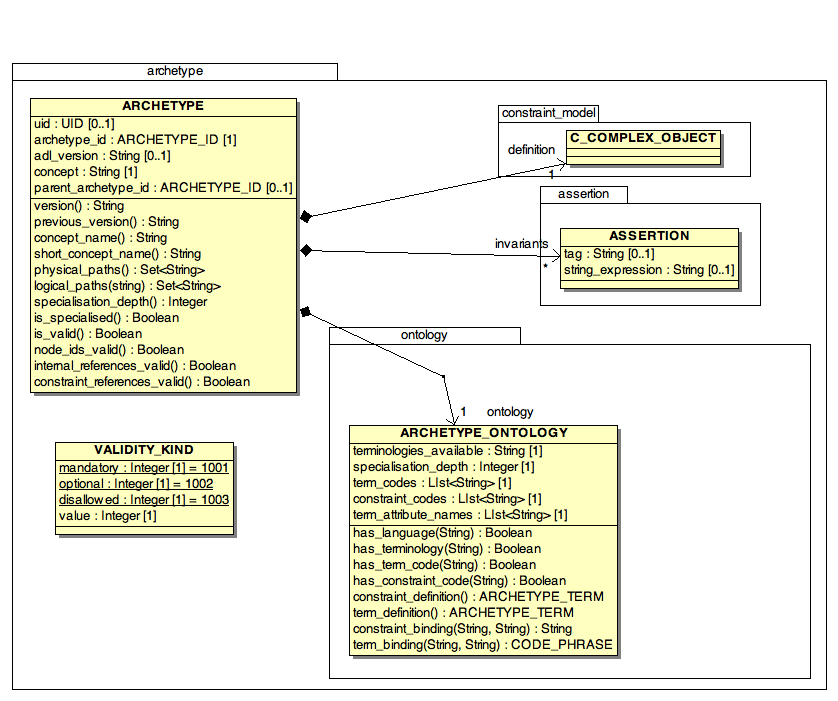
archetype_class_diag (am)
Classes in the am.archetype package.
Includes ARCHETYPE, VALIDITY_KIND.
Class ARCHETYPE |
Class VALIDITY_KIND |
1.1.2.2.2 Package constraint_model
The archetype Constraint Model is completely generic, and is designed to express the semantics of constraints
on instances of classes which are themselves described in UML (or a similar object-oriented meta-model).
Accordingly, the major abstractions in this model correspond to major abstractions in object-oriented formalisms,
including several variations of the notion of object' and the notion of attribute'. The notion of object' rather
than class' or type' is used because archetypes are about constraints on data (i.e. instances', or objects') rather
than models, which are constructed from classes'.
- C++ namespace : openehr
- Java package : org.openehr.am.archetype.constraint_model
1.1.2.2.2.1 Class View constraint_model_cv
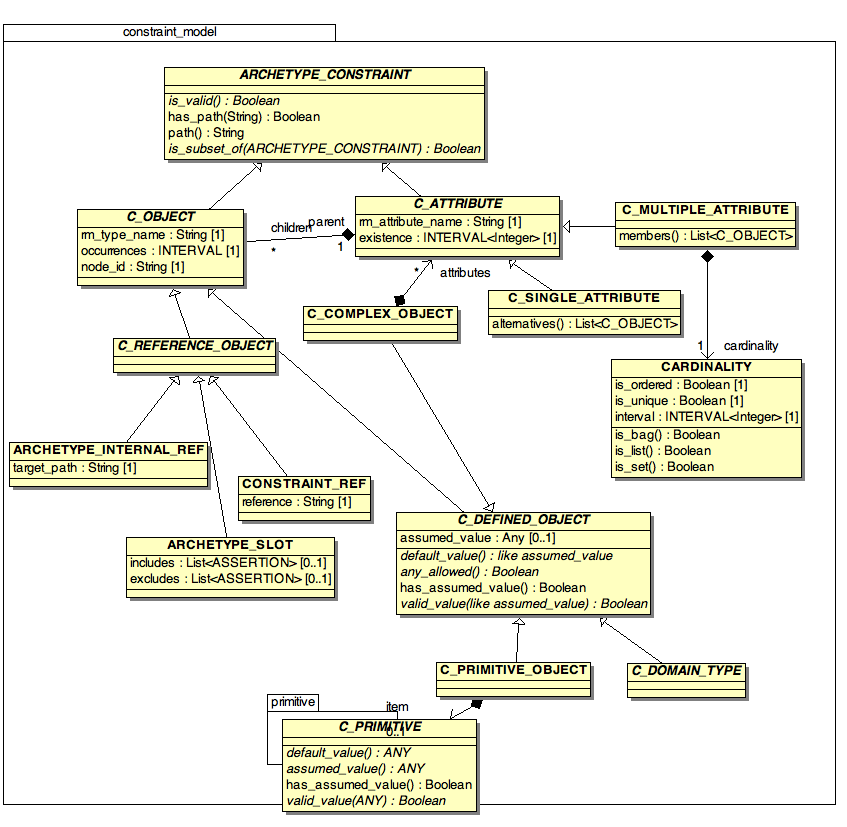
constraint_model_class_diag (am)
Classes in the am.archetype.constraint_model package
Class ARCHETYPE_CONSTRAINT |
Class C_OBJECT |
Class C_ATTRIBUTE |
Class C_REFERENCE_OBJECT |
Class C_DEFINED_OBJECT |
Class C_SINGLE_ATTRIBUTE |
Class C_MULTIPLE_ATTRIBUTE |
Class CARDINALITY |
Class ARCHETYPE_INTERNAL_REF |
Class ARCHETYPE_SLOT |
Class CONSTRAINT_REF |
Class C_PRIMITIVE_OBJECT |
Class C_COMPLEX_OBJECT |
Class C_DOMAIN_TYPE |
1.1.2.2.2.2 Deployment View constraint_model_dv
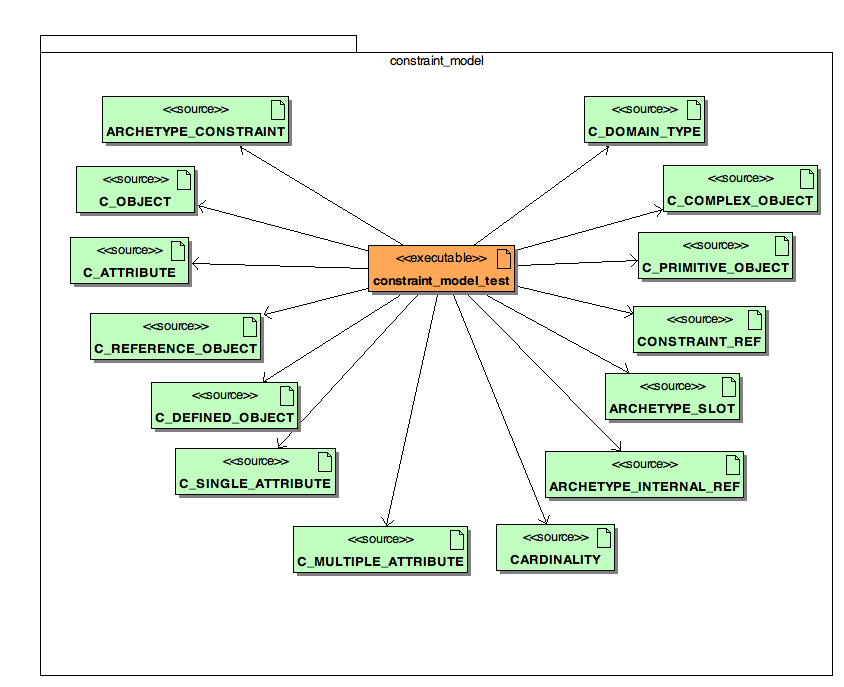
constraint_model_deploy
Shows testing module layout for am.archetype.constraint_model package.
Artifact ARCHETYPE_CONSTRAINT |
Stereotype: source
Artifact source associated with : ARCHETYPE_CONSTRAINT
Artifact C_OBJECT |
Stereotype: source
Artifact source associated with : C_OBJECT
Artifact C_ATTRIBUTE |
Stereotype: source
Artifact source associated with : C_ATTRIBUTE
Artifact C_REFERENCE_OBJECT |
Stereotype: source
Artifact source associated with : C_REFERENCE_OBJECT
Artifact C_DEFINED_OBJECT |
Stereotype: source
Artifact source associated with : C_DEFINED_OBJECT
Artifact C_SINGLE_ATTRIBUTE |
Stereotype: source
Artifact source associated with : C_SINGLE_ATTRIBUTE
Artifact C_MULTIPLE_ATTRIBUTE |
Stereotype: source
Artifact source associated with : C_MULTIPLE_ATTRIBUTE
Artifact CARDINALITY |
Stereotype: source
Artifact source associated with : CARDINALITY
Artifact ARCHETYPE_INTERNAL_REF |
Stereotype: source
Artifact source associated with : ARCHETYPE_INTERNAL_REF
Artifact ARCHETYPE_SLOT |
Stereotype: source
Artifact source associated with : ARCHETYPE_SLOT
Artifact CONSTRAINT_REF |
Stereotype: source
Artifact source associated with : CONSTRAINT_REF
Artifact C_PRIMITIVE_OBJECT |
Stereotype: source
Artifact source associated with : C_PRIMITIVE_OBJECT
Artifact C_COMPLEX_OBJECT |
Stereotype: source
Artifact source associated with : C_COMPLEX_OBJECT
Artifact C_DOMAIN_TYPE |
Stereotype: source
Artifact source associated with : C_DOMAIN_TYPE
Artifact constraint_model_test |
A module for testing the am.archetype.constraint_model package.
Stereotype: executable
executable associated with : C_DOMAIN_TYPE, CONSTRAINT_REF, C_DEFINED_OBJECT, ARCHETYPE_SLOT, C_COMPLEX_OBJECT, CARDINALITY, ARCHETYPE_INTERNAL_REF, ARCHETYPE_CONSTRAINT, C_MULTIPLE_ATTRIBUTE, C_PRIMITIVE_OBJECT, C_ATTRIBUTE, C_OBJECT, C_REFERENCE_OBJECT, C_SINGLE_ATTRIBUTE
1.1.2.2.2.3 Package primitive
Ultimately any archetype definition will devolve down to leaf node constraints on
instances of primitive types. The primitive package defines the semantics of constraint
on such types.
- C++ namespace : openehr
- Java package : org.openehr.am.archetype.constraint_model.primitive
1.1.2.2.2.3.1 Class View primitive_cv
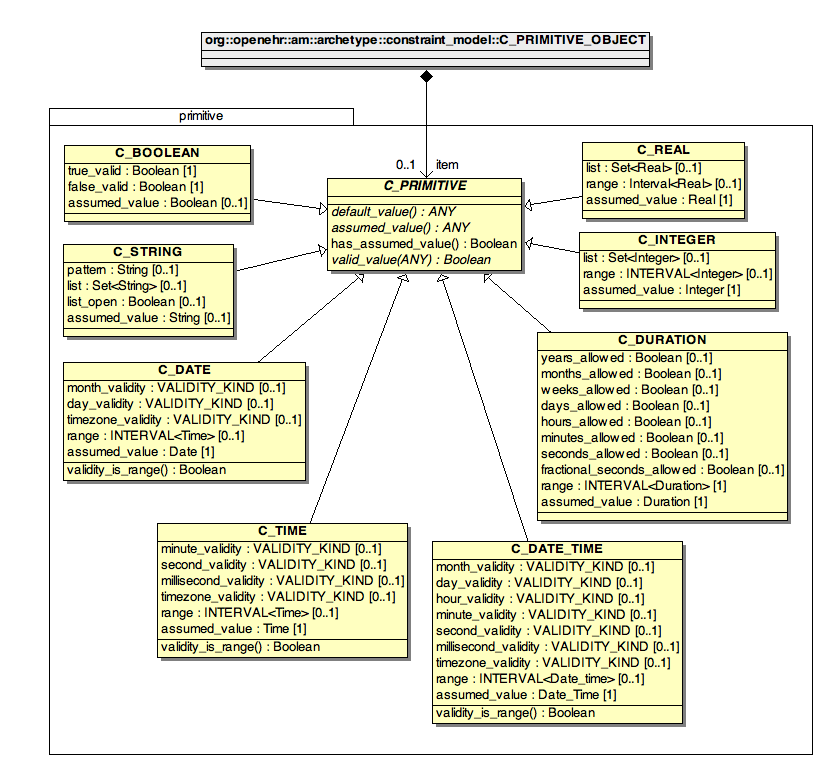
primitive_class_diag (am)
Class C_PRIMITIVE |
Class C_BOOLEAN |
Class C_STRING |
Class C_INTEGER |
Class C_REAL |
Class C_DATE |
Class C_DATE_TIME |
Class C_TIME |
Class C_DURATION |
1.1.2.2.2.3.2 Deployment View primitive_dv
Artifact C_DURATION |
Stereotype: source
Artifact source associated with : C_DURATION
Artifact C_DATE_TIME |
Stereotype: source
Artifact source associated with : C_TIME, C_DATE_TIME
Artifact C_TIME |
Stereotype: source
Artifact source
Artifact C_DATE |
Stereotype: source
Artifact source associated with : C_DATE
Artifact C_REAL |
Stereotype: source
Artifact source associated with : C_REAL
Artifact C_INTEGER |
Stereotype: source
Artifact source associated with : C_INTEGER
Artifact C_STRING |
Stereotype: source
Artifact source associated with : C_STRING
Artifact C_BOOLEAN |
Stereotype: source
Artifact source associated with : C_BOOLEAN
Artifact C_PRIMITIVE |
Stereotype: source
Artifact source associated with : C_PRIMITIVE
1.1.2.2.3 Package ontology
All linguistic and terminological entities in an archetype are represented in the ontology part of an
archetype, whose semantics are given in the Ontology package
- C++ namespace : openehr
- Java package : org.openehr.am.ontology
1.1.2.2.3.1 Class View ontology_cv
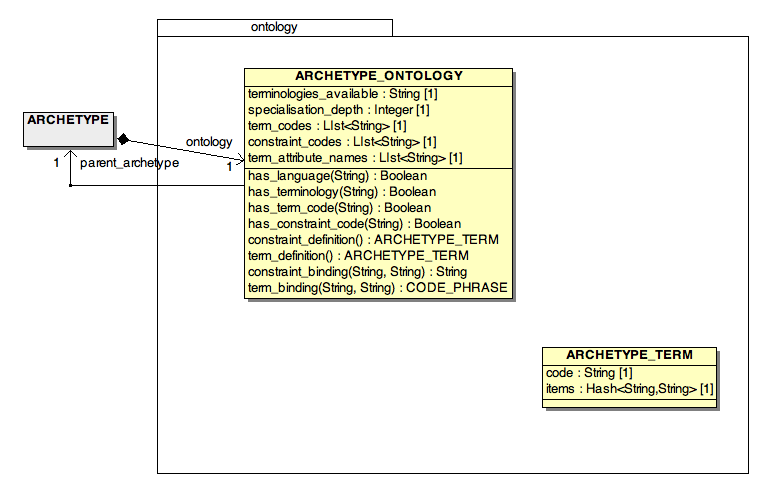
ontology_class_diag (am)
Classes in the am.archetype.ontology package.
Includes ARCHETYPE_ONTOLOGY, ARCHETYPE_TERM.
Class ARCHETYPE_ONTOLOGY |
Class ARCHETYPE_TERM |
1.1.2.2.3.2 Deployment View ontology_dv
Artifact ARCHETYPE_ONTOLOGY |
Stereotype: source
Artifact source associated with : ARCHETYPE_ONTOLOGY
Artifact ARCHETYPE_TERM |
Stereotype: source
Artifact source associated with : ARCHETYPE_TERM
1.1.2.2.4 Package assertion
Assertions are expressed in archetypes in typed first-order predicate logic (FOL). They are used in
two places: to express archetype slot constraints, and to express invariants in complex object con-
straints. In both of these places, their role is to constrain something inside the archetype. Constraints
on external resources such as terminologies are expressed in the constraint binding part of the arche-
type ontology.
- C++ namespace : openehr
- Java package : org.openehr.am.archetype.assertion
1.1.2.2.4.1 Class View assertion_cv
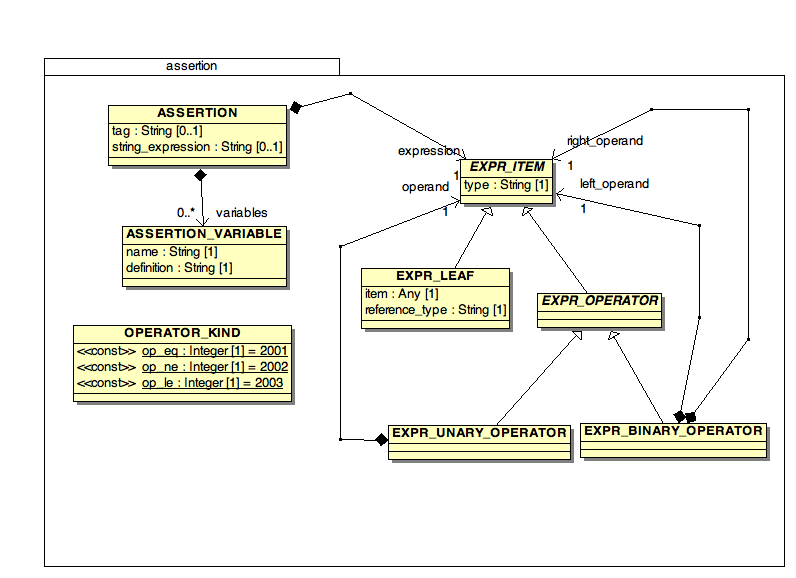
assertion_class_diag (am)
Classes in the am.archetype.assertion package.
Includes ASSERTION, ASSERTION_VARIABLE and operator classes.
Class ASSERTION |
Class ASSERTION_VARIABLE |
Class OPERATOR_KIND |
Class EXPR_ITEM |
Class EXPR_LEAF |
Class EXPR_OPERATOR |
Class EXPR_UNARY_OPERATOR |
Class EXPR_BINARY_OPERATOR |
1.1.2.2.4.2 Deployment View assertion_dv
Artifact ASSERTION |
Stereotype: source
Artifact source associated with : ASSERTION
Artifact ASSERTION_VARIABLE |
Stereotype: source
Artifact source associated with : ASSERTION_VARIABLE
Artifact OPERATOR_KIND |
Stereotype: source
Artifact source associated with : OPERATOR_KIND
Artifact EXPR_ITEM |
Stereotype: source
Artifact source associated with : EXPR_ITEM
Artifact EXPR_LEAF |
Stereotype: source
Artifact source associated with : EXPR_LEAF
Artifact EXPR_OPERATOR |
Stereotype: source
Artifact source associated with : EXPR_OPERATOR
Artifact EXPR_UNARY_OPERATOR |
Stereotype: source
Artifact source associated with : EXPR_UNARY_OPERATOR
Artifact EXPR_BINARY_OPERATOR |
Stereotype: source
Artifact source associated with : EXPR_BINARY_OPERATOR
1.1.2.2.5 Deployment View archetype_dv
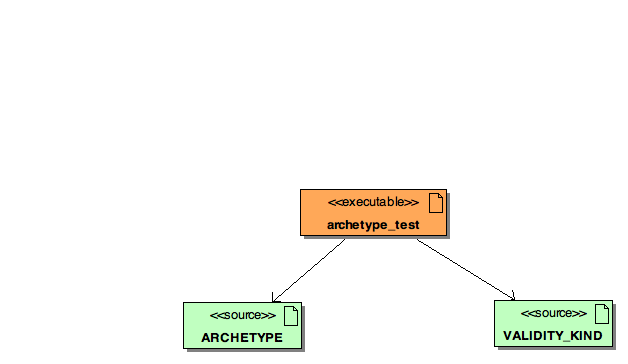
archetype_deploy
Shows testing module layout for am.archetype package.
Artifact ARCHETYPE |
Stereotype: source
Artifact source associated with : ARCHETYPE
Artifact VALIDITY_KIND |
Stereotype: source
Artifact source associated with : VALIDITY_KIND
Artifact archetype_test |
A module for testing the am.archetype package.
Stereotype: executable
executable associated with : VALIDITY_KIND, ARCHETYPE
1.1.2.3 Package template
Classes comprising the am.template package.
- C++ namespace : openehr
- Java package : org.openehr.am.template
1.1.2.3.1 Class View template_cv
1.1.2.3.2 Deployment View template_dv
1.1.2.3.3 Package template_spec
The "specification" form of a template.
- C++ namespace : openehr
- Java package : org.openehr.am.template.template_spec
1.1.2.3.3.1 Class View template_spec_cv
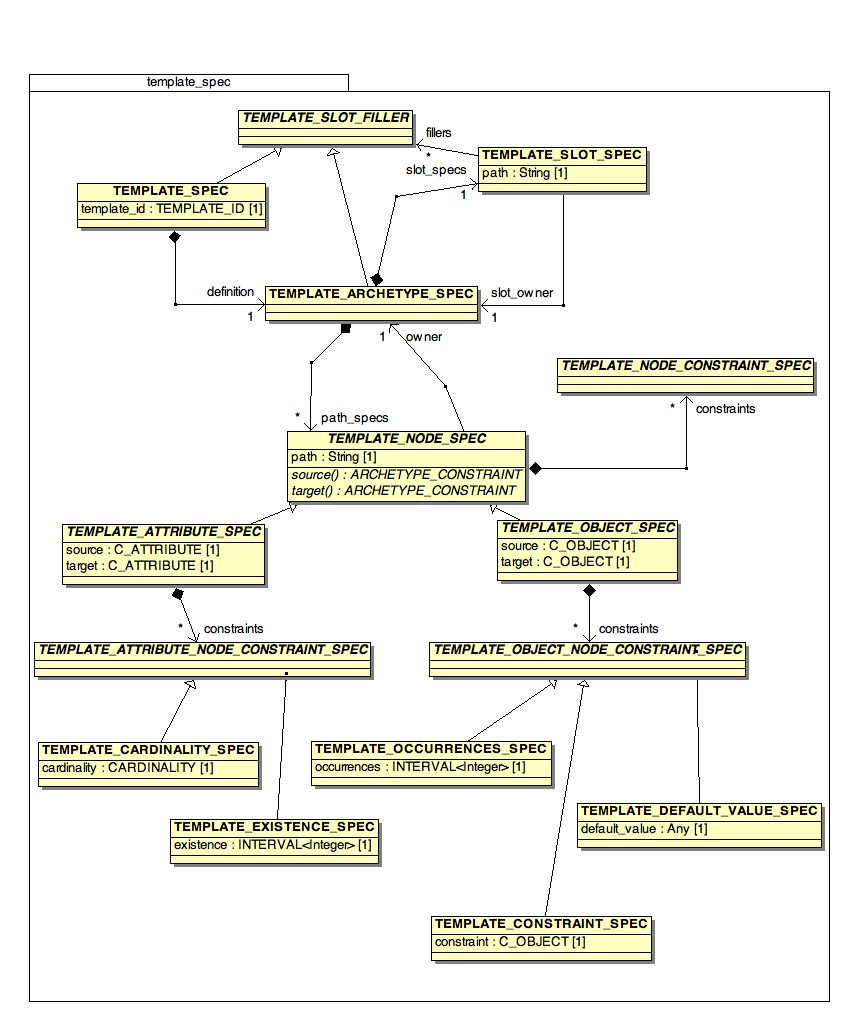
template_spec_class_diag (am)
Class TEMPLATE_SPEC |
Class TEMPLATE_SLOT_FILLER |
Class TEMPLATE_SLOT_SPEC |
Class TEMPLATE_ARCHETYPE_SPEC |
Class TEMPLATE_NODE_SPEC |
Class TEMPLATE_ATTRIBUTE_SPEC |
Class TEMPLATE_OBJECT_SPEC |
Class TEMPLATE_EXISTENCE_SPEC |
Class TEMPLATE_CONSTRAINT_SPEC |
1.1.2.3.3.2 Deployment View template_spec_dv
Artifact TEMPLATE_SPEC |
Stereotype: source
Artifact source associated with : TEMPLATE_SPEC
Artifact TEMPLATE_SLOT_FILLER |
Stereotype: source
Artifact source associated with : TEMPLATE_SLOT_FILLER
Artifact TEMPLATE_SLOT_SPEC |
Stereotype: source
Artifact source associated with : TEMPLATE_SLOT_SPEC
Artifact TEMPLATE_ARCHETYPE_SPEC |
Stereotype: source
Artifact source associated with : TEMPLATE_ARCHETYPE_SPEC
Artifact TEMPLATE_NODE_SPEC |
Stereotype: source
Artifact source associated with : TEMPLATE_NODE_SPEC
Artifact TEMPLATE_NODE_CONSTRAINT_SPEC |
Stereotype: source
Artifact source associated with : TEMPLATE_NODE_CONSTRAINT_SPEC
Artifact TEMPLATE_ATTRIBUTE_SPEC |
Stereotype: source
Artifact source associated with : TEMPLATE_ATTRIBUTE_SPEC
Artifact TEMPLATE_ATTRIBUTE_NODE_CONSTRAINT_SPEC |
Stereotype: source
Artifact source associated with : TEMPLATE_ATTRIBUTE_NODE_CONSTRAINT_SPEC
Artifact TEMPLATE_OBJECT_SPEC |
Stereotype: source
Artifact source associated with : TEMPLATE_OBJECT_SPEC
Artifact TEMPLATE_OBJECT_NODE_CONSTRAINT_SPEC |
Stereotype: source
Artifact source associated with : TEMPLATE_OBJECT_NODE_CONSTRAINT_SPEC
Artifact TEMPLATE_CARDINALITY_SPEC |
Stereotype: source
Artifact source associated with : TEMPLATE_CARDINALITY_SPEC
Artifact TEMPLATE_EXISTENCE_SPEC |
Stereotype: source
Artifact source associated with : TEMPLATE_EXISTENCE_SPEC
Artifact TEMPLATE_OCCURRENCES_SPEC |
Stereotype: source
Artifact source associated with : TEMPLATE_OCCURRENCES_SPEC
Artifact TEMPLATE_DEFAULT_VALUE_SPEC |
Stereotype: source
Artifact source associated with : TEMPLATE_DEFAULT_VALUE_SPEC
Artifact TEMPLATE_CONSTRAINT_SPEC |
Stereotype: source
Artifact source associated with : TEMPLATE_CONSTRAINT_SPEC
1.1.2.3.4 Package operational_template
1.1.2.4 Package openehr_profile
The openEHR Archetype Profile is used to define custom archetype classes and in some cases, custom syntax
equivalents (essentially shorthands) that can be used instead of the AOM generic classes for archetyping certain RM classes.
The internal structure of the package mimics the structure of the reference model it profiles, i.e. the
openEHR reference model. This is done to make software development easier, even though the package structure
may be sparsely populated. Packages need only be defined where there are custom types to be defined; the only
ones currently defined are in the data_types package.
- C++ namespace : openehr
- Java package : org.openehr.am.openehr_profile
1.1.2.4.1 Package data_types
- C++ namespace : openehr
- Java package : org.openehr.am.openehr_profile/data_types
1.1.2.4.1.1 Package quantity
The am.openehr_profile.data_types quantity package defines custom types for constraining the
RM quantity types DV_QUANTITY, DV_QUANTITY_ITEM, DV_ORDINAL.
- C++ namespace : openehr
- Java package : org.openehr.am.openehr_profile.data_types.quantity
1.1.2.4.1.2 Package text
The am.openehr_profile.data_types.text package defines custom types for constraining the
corresponging RM type.
- C++ namespace : openehr
- Java package : org.openehr.am.openehr_profile.data_types.text
1.1.2.4.1.2.1 Class View text_cv
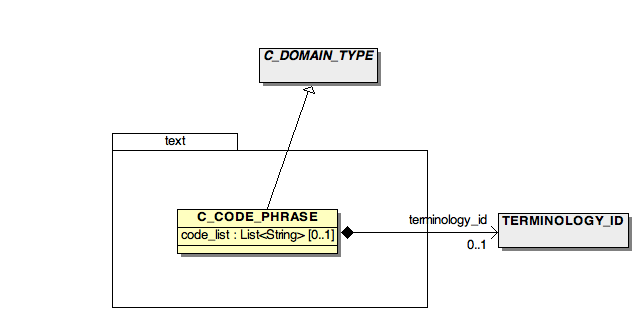
text_class_diag (am)
Classes defined in the am.openehr_profile.data_types.text package.
Class C_CODE_PHRASE |
1.1.2.4.1.2.2 Deployment View text_dv
1.1.2.4.1.3 Package basic
The am.openehr_profile.data_types.basic package defines custom types for constraining
the RM state types.
- C++ namespace : openehr
- Java package : org.openehr.am.openehr_profile.data_types.basic
1.1.2.4.1.3.1 Class View basic_cv
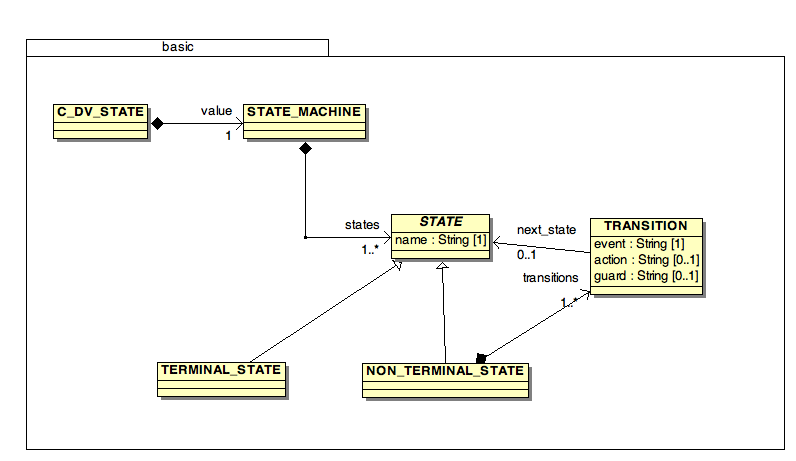
basic_class_diag (am)
Classes in the am.openehr_profile.basic package
Class C_DV_STATE |
Class STATE_MACHINE |
Class STATE |
Class TERMINAL_STATE |
Class NON_TERMINAL_STATE |
Class TRANSITION |
1.1.2.4.1.3.2 Deployment View basic_dv
Artifact C_DV_STATE |
Stereotype: source
Artifact source associated with : C_DV_STATE
Artifact STATE_MACHINE |
Stereotype: source
Artifact source associated with : STATE_MACHINE
Artifact STATE |
Stereotype: source
Artifact source associated with : STATE
Artifact TERMINAL_STATE |
Stereotype: source
Artifact source associated with : TERMINAL_STATE
Artifact NON_TERMINAL_STATE |
Stereotype: source
Artifact source associated with : NON_TERMINAL_STATE
Artifact TRANSITION |
Stereotype: source
Artifact source associated with : TRANSITION
1.1.3 Package sm
- C++ namespace : openehr
- Java package : org.openehr.sm
1.1.3.1 Package archetype
The archetype service model defines the interface to online repositories of archetypes, and can be used both by GUI applications designed for human browsing as well as access by other software services such as the EHR.
- C++ namespace : openehr
- Java package : org.openehr.sm.archetype
1.1.3.2 Package virtual_ehr
The virtual EHR API defines the fine-grained interface to EHR data, at the level of Compositions and below. It allows an application to create new EHR information, and to request parts of an existing EHR and modify them. This API enables fine-grained archetype-mediated data manipulation.
Changes to the EHR are committed via the EHR service.
- C++ namespace : openehr
- Java package : org.openehr.sm.virtual_ehr
1.1.3.3 Package workflow
- C++ namespace : openehr
- Java package : org.openehr.sm.workflow
1.1.3.4 Package terminology
The terminology interface service provides the means for all other services to access any terminology available in the health information environment, including basic classification vocabularies such as ICDx and ICPC, as well as more advanced ontology-based terminologies. Following the concept of division of responsibilities in a system-of-systems context, the terminology interface abstracts the different underlying architectures of each terminology, allowing other services in the environment to access terms in a standard way. The terminology service is thus the gateway to all ontology- and terminology-based knowledge services in the environment, which along with services for accessing guidelines, drug data and other reference data enables inferencing and decision support to be carried out in the environment.
- C++ namespace : openehr
- Java package : org.openehr.sm.terminology
1.1.3.5 Package ehr
The EHR service model defines the coarse-grained interface to electronic health record service. The level of granularity is openEHR Contributions and Compositions, i.e. a version-control / change-set interface.
Part of the model defines the semantics of server-side querying, i.e. queries which cause large amounts of data to be processed, generally returning small aggregated answers, such as averages, or sets of ids of patients matching a particular criterion.
- C++ namespace : openehr
- Java package : org.openehr.sm.ehr
1.1.3.6 Package demographic
- C++ namespace : openehr
- Java package : org.openehr.sm.demographic
1.1.4 Deployment View openehr_dv
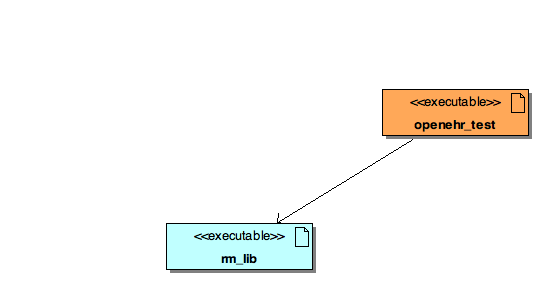
openehr_test_deploy
For testing openehr class implementations
Artifact openehr_test |
Stereotype: executable
Properties:
- genpro footer:
- genpro config:debug warn_on qt
- genpro pro:/openehr/implementations/UML/openEHR_1.0.1/src/c++/openehr_test.pro
- genpro path:/openehr/implementations/UML/1.0.1/src/c++/
- genpro includepath:executable not yet managed
- genpro defines:WITHCPP WITHJAVA WITHPHP WITHIDL
- genpro objectsdir:/openehr/implementations/UML/openEHR_1.0.1/target/c++/openehr_test
- genpro dependpath:
- genpro target:/openehr/implementations/UML/openEHR1.0.1/target/c++/openehr_test
- genpro tmplt:app
executable associated with : rm_lib
